SPIDERS
-- PAGE 4 JUMPING SPIDERS
This
page was born 12/18/2003. Rickubis designed it.
(such as it
is.) Last update: 03/12/2024
Images
and contents on this page copyright ©2002-
2024 Richard M. Dashnau spiders page 1 2 3 5 6 7 8
Go back to my
home page, Welcome
to rickubis.com
Go
back to the RICKUBISCAM
page.
This
is my fourth page of information I've found about spiders. Most
of
these
pictures were taken at Brazos Bend State Park. I hope that, like
me,
the
next time you see a spider
(and they are almost everywhere), you'll take
a second to admire their form and function. On this page,
we
have
the jumping spiders, or Salticidae.
12/03/2023 Brazos Bend State Park It is not within my abilities to
share how wonderful a visit to the park can be. I often see more
in a single day than I could fit onto a
single update to
this...whatever it is I've been doing. I try to share
observations new to me, or novel updates to what I've shared before.
Sometimes, I can't possibly the
full scope of what I've seen,
so
I don't even try. But other times, I try anyway. This is one
of
those times.
When I approached the Southeast bend of the 40 Acre
Lake trail (about 8:20am), the low morning sunlight brightened the
dew
caught by silk webs. I can only guess at
the species of spider that was on the web; possibly an Arabesque
Orbweaver Neoscona
arabesca; but there are a number of orbwevars with
"chunky" bodies here.
(While this is not a jumping spider, I'm leaving it on this with the
rest of the observations)
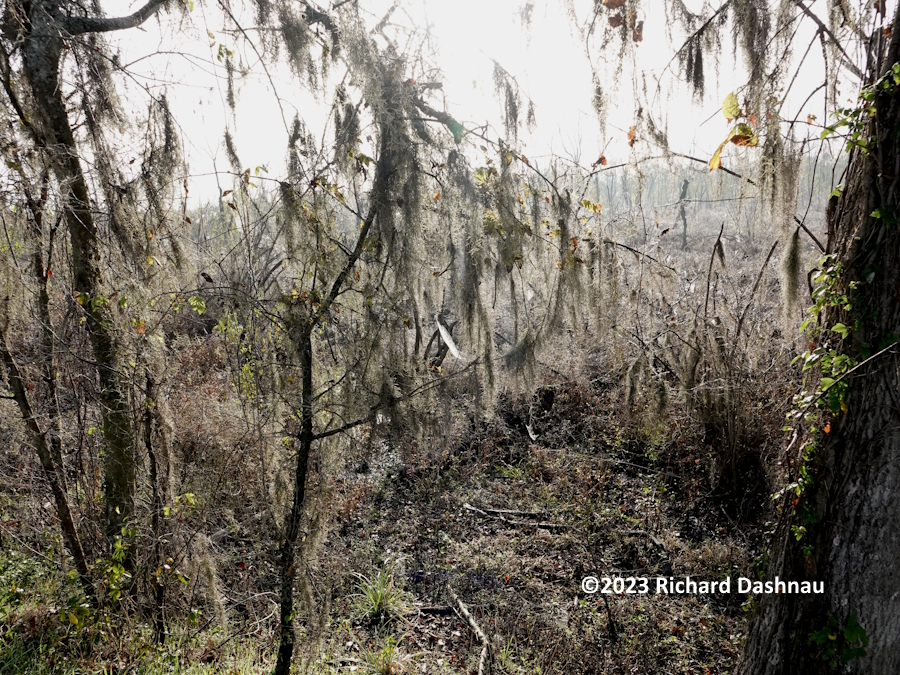
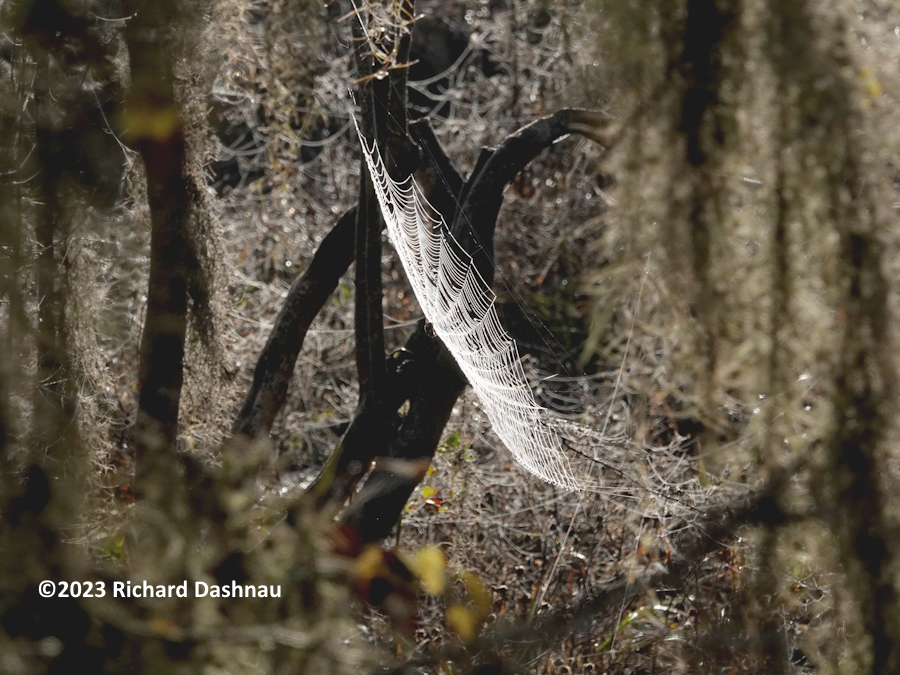
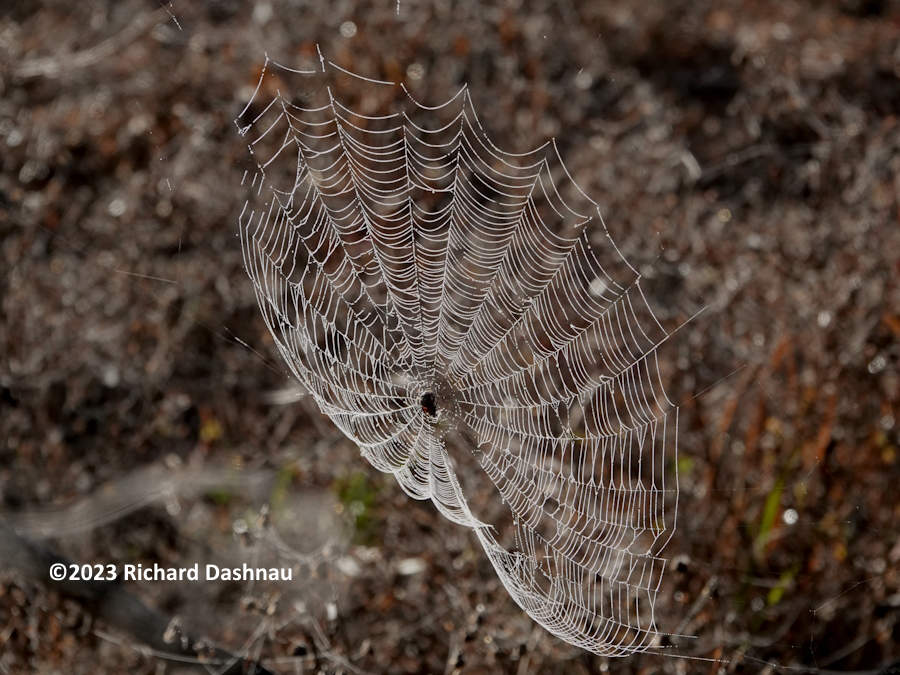
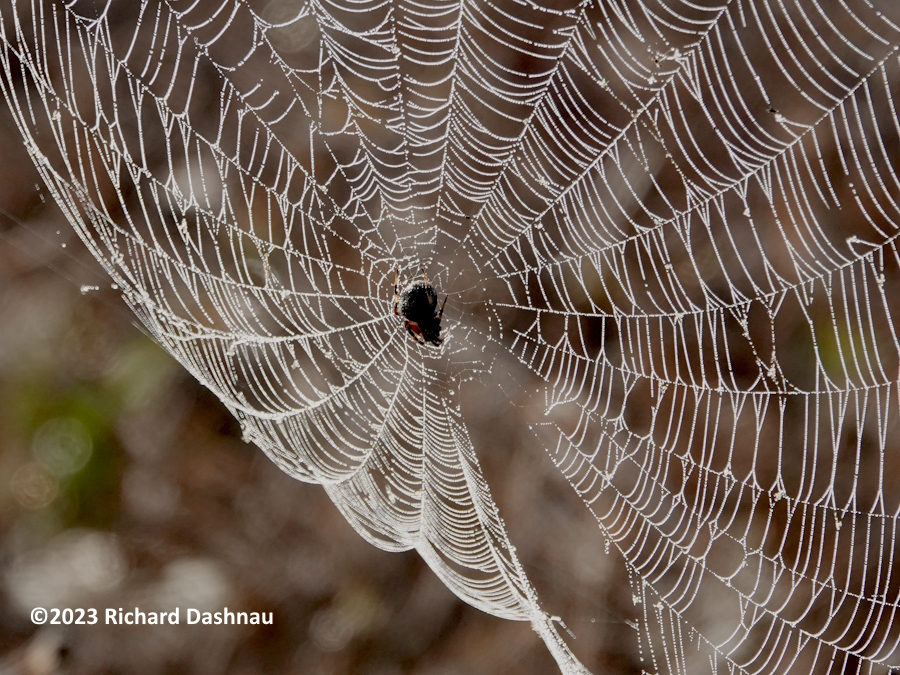
That
was amazing! But then, I got to the Spillway Trail, near the
Observation Tower. I stared, awestruck, at the view to the
Southeast. The entire area was alight with silver!
It looked like
ice--but it wasn't. It was all silk webbing covered with dew! I took
pictures, but couldn't capture the distance covered by this
phenomenon.
Tried to, anyway.
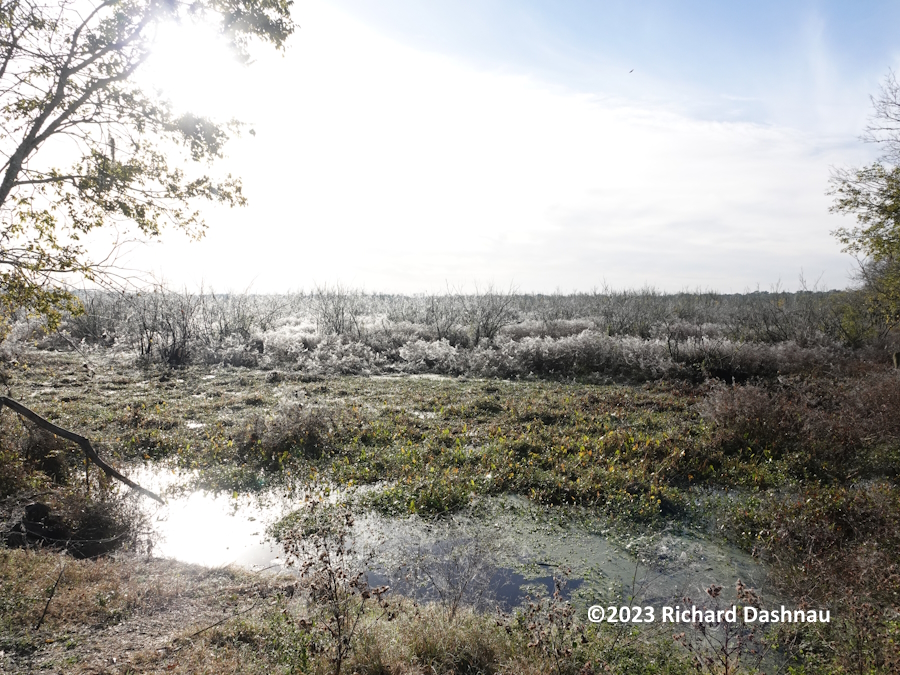
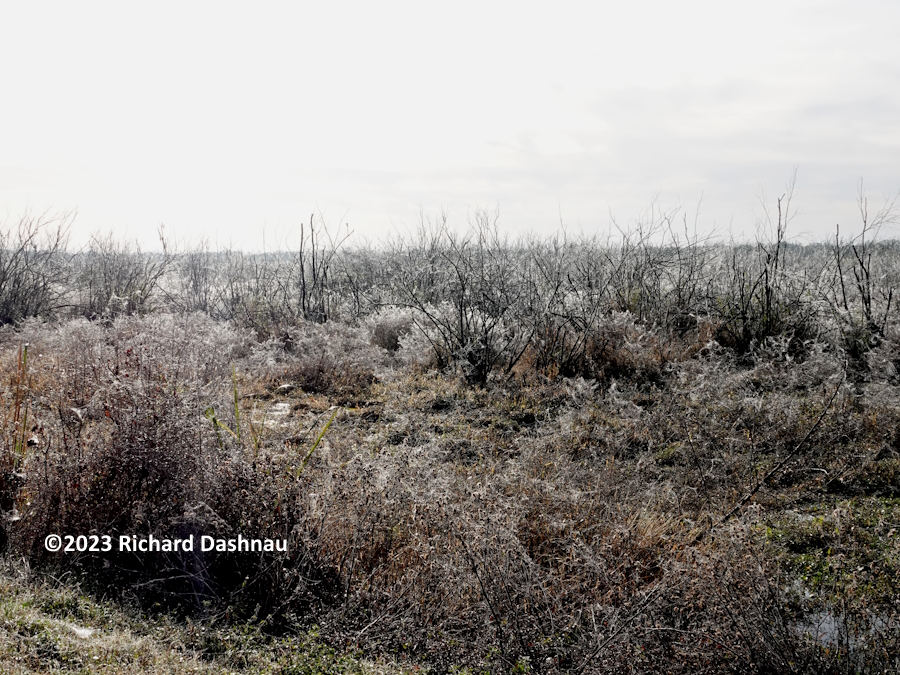
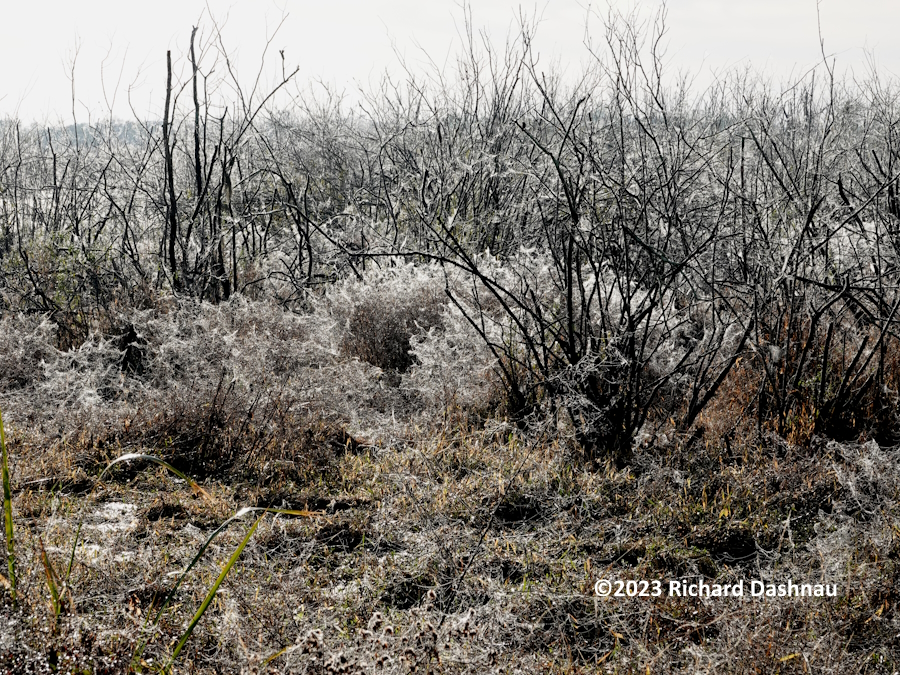
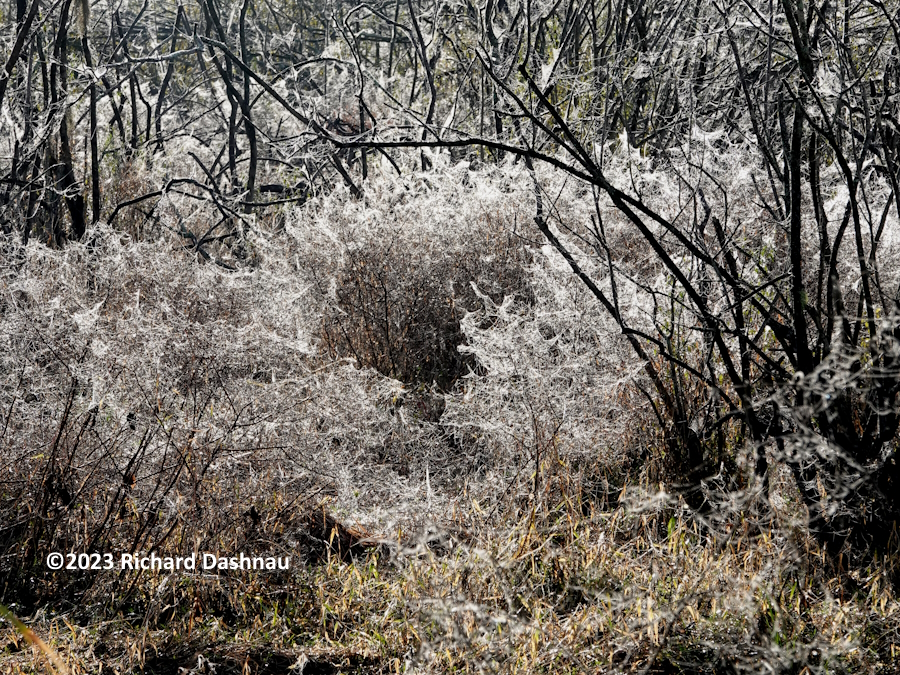
I was
standing on the Spillway
Trail.
The "scrub" growth starts about 40 yards away. I could only
use
camera zoom to add details. I call this "silk" in general, because--
although
I suspect that it was made by spiders--I have no way to verify the
source. I finally continued down the trail, where I spent hours near
the mother gator and her
pod of baby alligators (as
shown on my page here). As the day progressed,
streamers of silk flew everywhere. While I tried looking at them for
spider inhabitants (since
I'd
thought that the silk was actually made by "ballooning" spiders), I
didn't find any. However, over the hours, I discovered 4 or 5
spiders
upon me. Usually, I either picked
them up by the their web and
hung them from a tree. I tried taking pictures of one of the
spiders--which was not as easy as one might think. I usually have
hardware hanging
off of me, and also carry a six-foot staff. So,
juggling a single camera with one hand to capture a critter on the
other was a bit tricky. I got it, though.
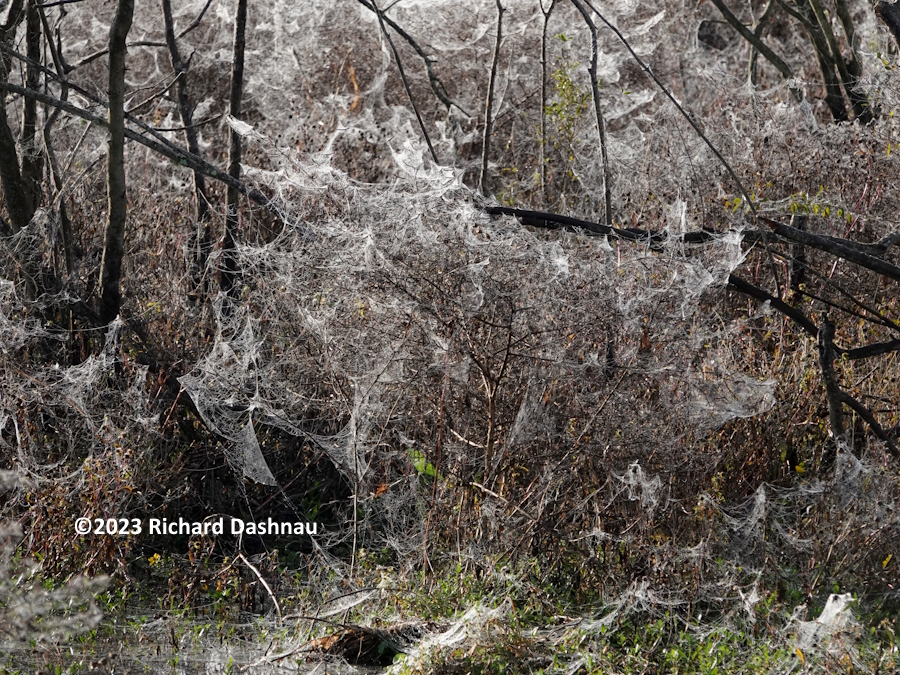
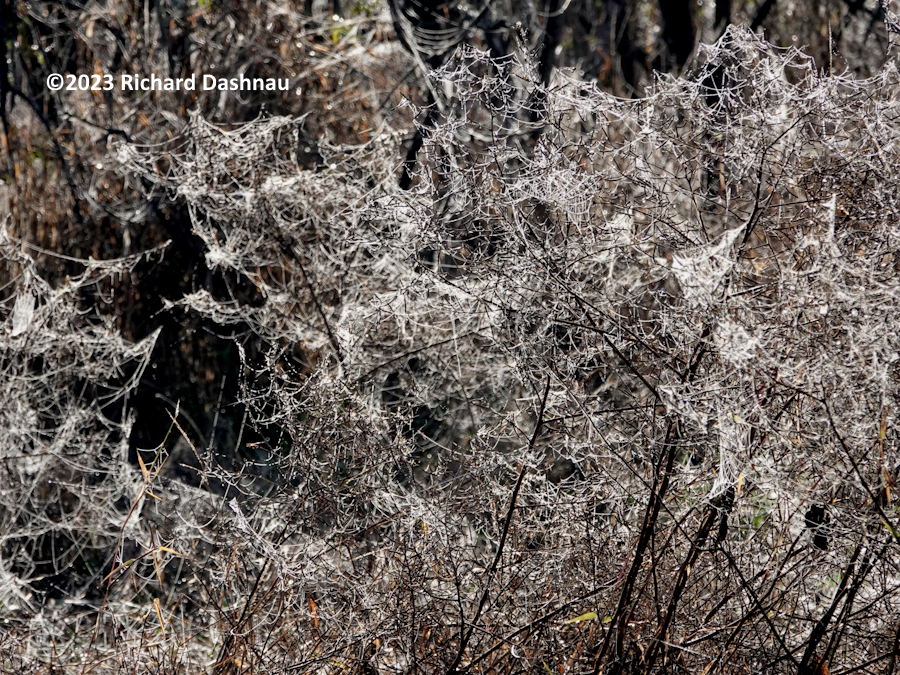
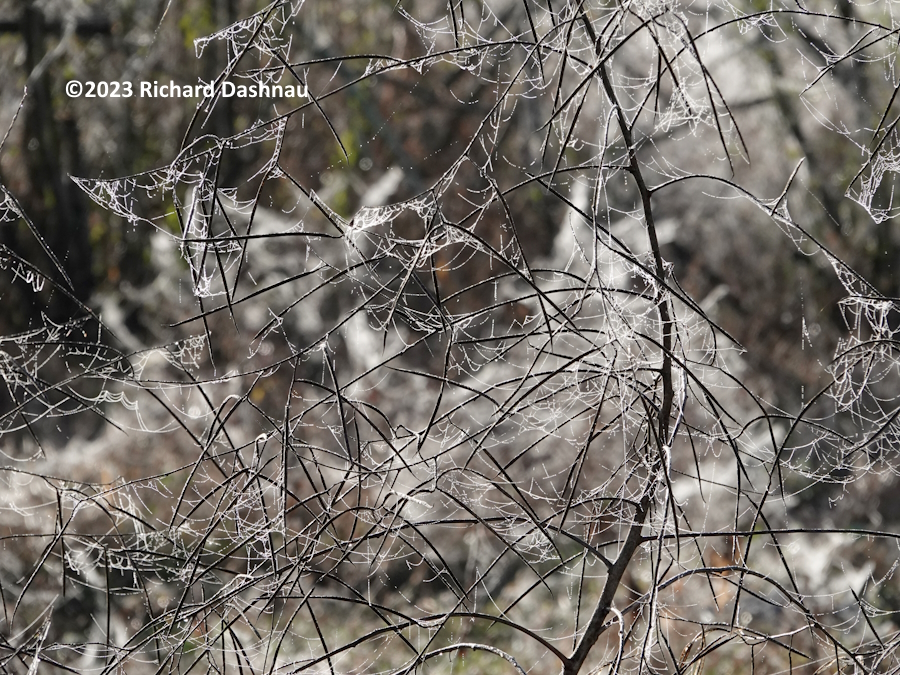
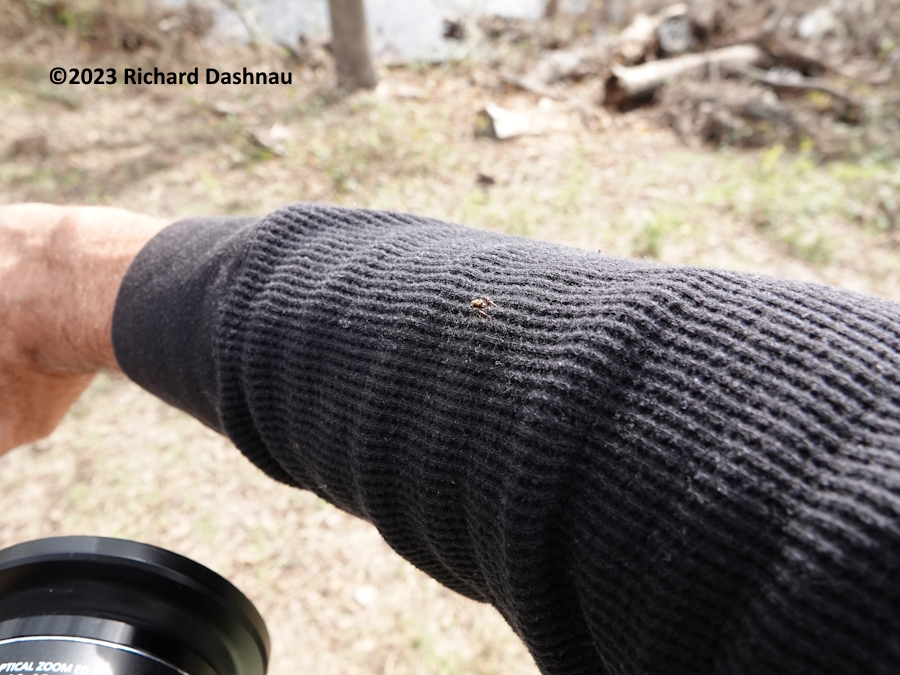
The
images below are cropped, from images taken with my usual settings.
I can tell it's one of the "jumping spiders", and it has a
brilliant metallic color. After poking
around a bit on the
Internet (and looking in Common Spiders of North America by Richard
A.
Bradley ©2013); I think it could be either a : Bronze Jumping
Spider
Eris militaris
, or Thin-Spined Jumping Spider Tutelina
elegans. But--I can't make out any markings on the spider.
This could be due to it being so young. Anyway, I know
it is a jumping spider.
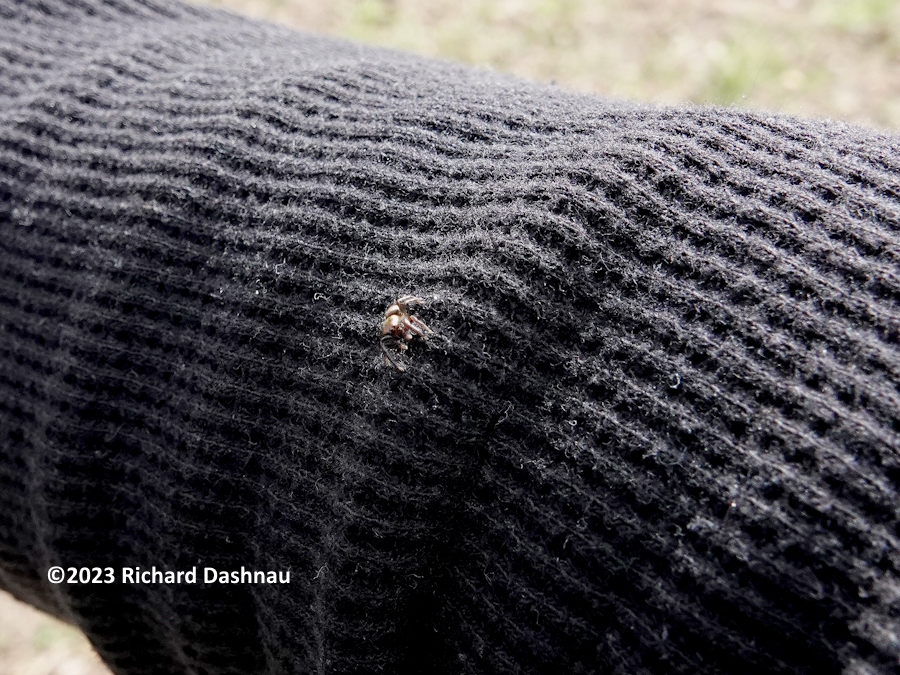
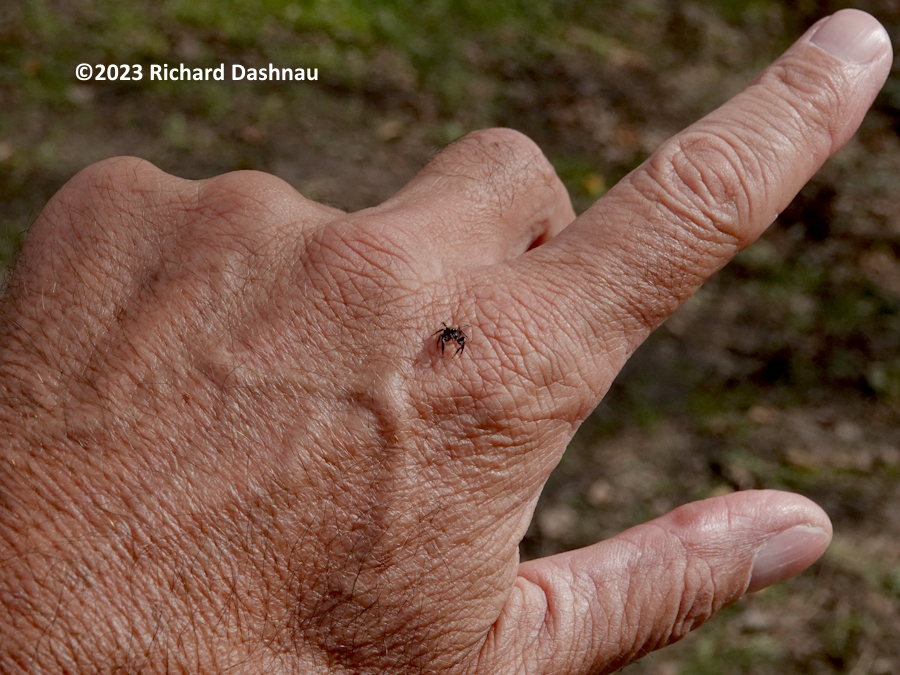
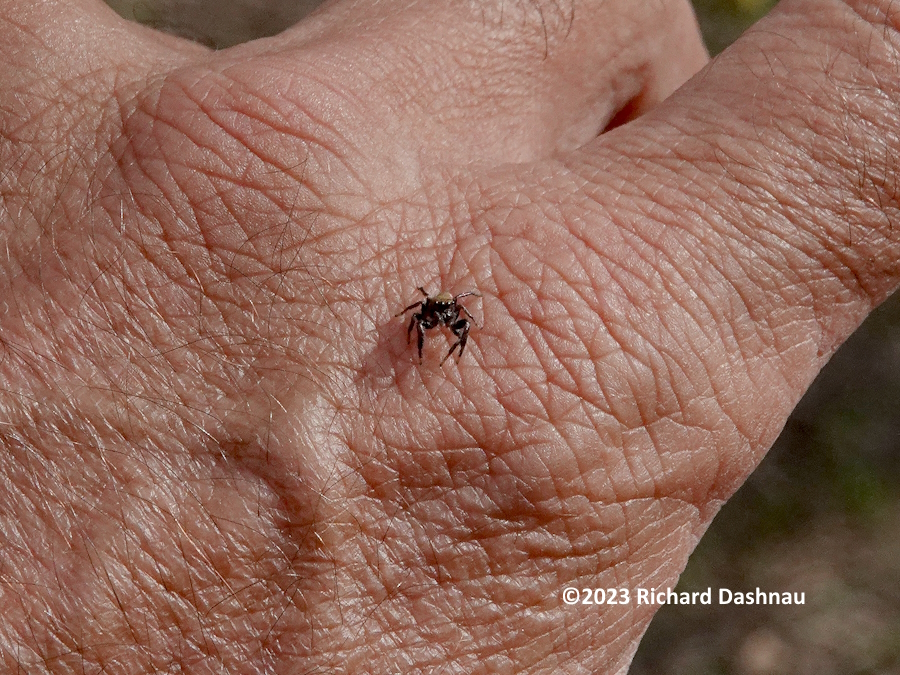
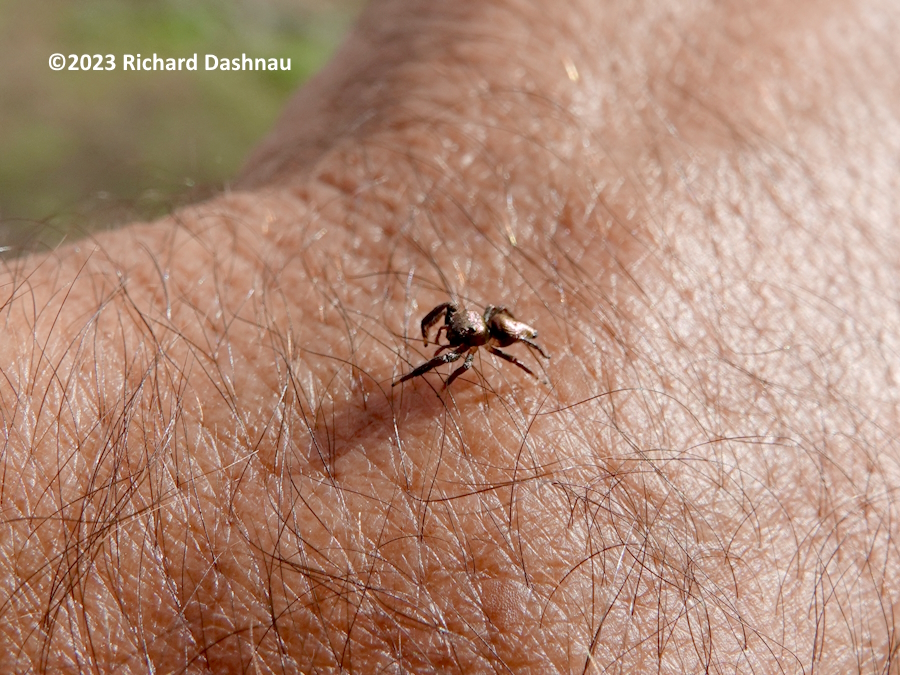
After
letting it try to tell time, I also release it to a nearby tree.
When I
returned to the Tower, about 3pm, the dew was gone, but a lot of the
silk webbing was still there.
When I see so much silk, I
wonder how it was produced. Spider silk is manufactured in a
spider's body, and requires metabolic energy and chemicals to
produce.
It costs
a spider to make it. What would motivate spiders (if it was
spiders) to produce so much silk? Was it all for transportation, and
just got tangled? Was it set out to trap prey?
In 2007,
there was a massive community spider web at Lake Tawokoni State
Park.
It made the news in a few places. The manager of the park at the
time
was a
previous employee of BBSP, so we got pictures directly from
the park. That turned out to be a collection of long-jawed
orbweavers (Tetragnathus) if I recall correctly.
The webs in that case were up in trees, and did catch many insects. In our case, the event
seemed more ephemeral.
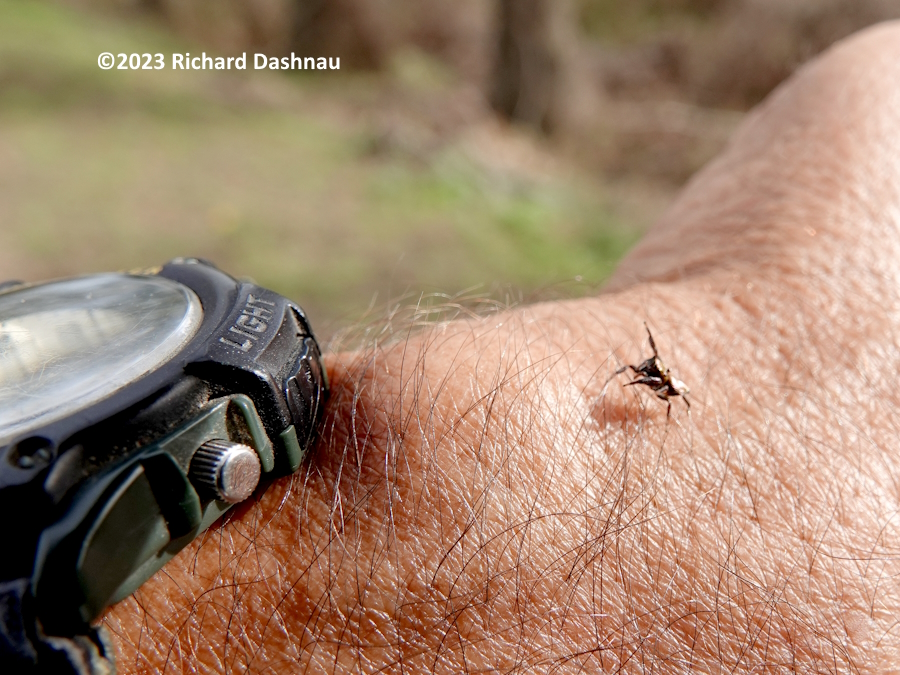
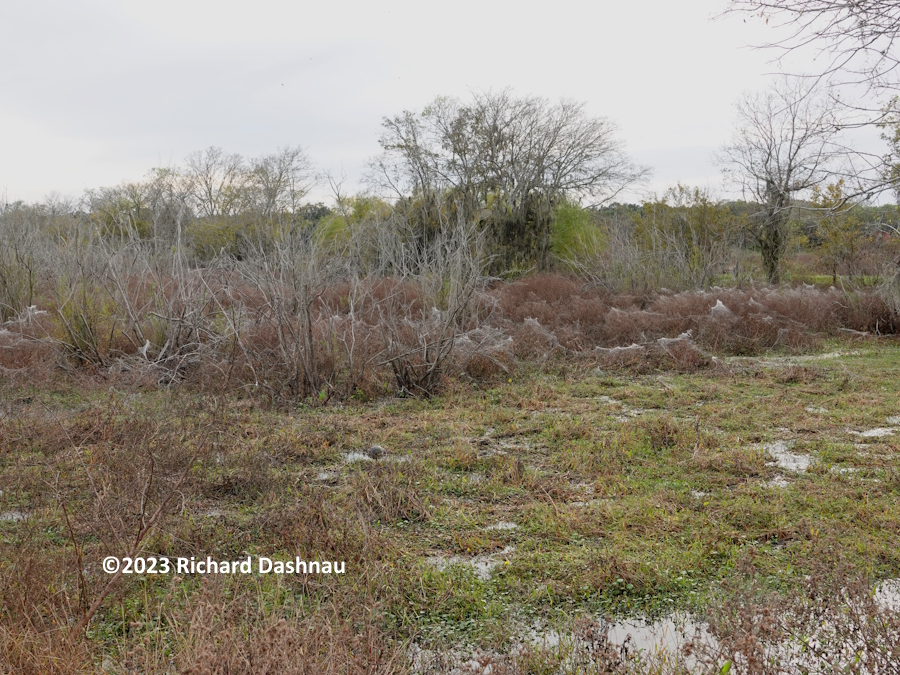
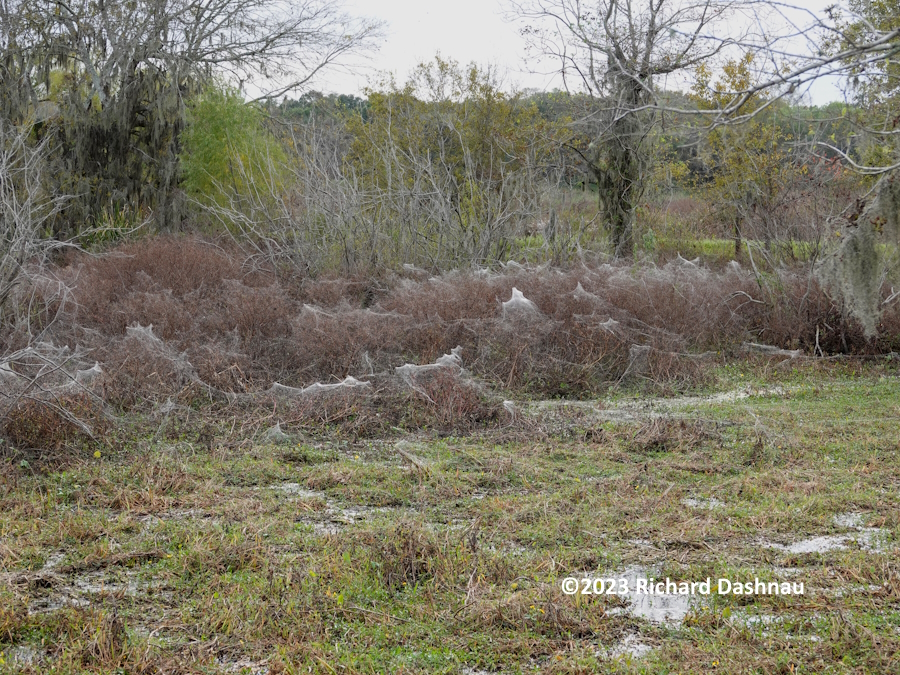
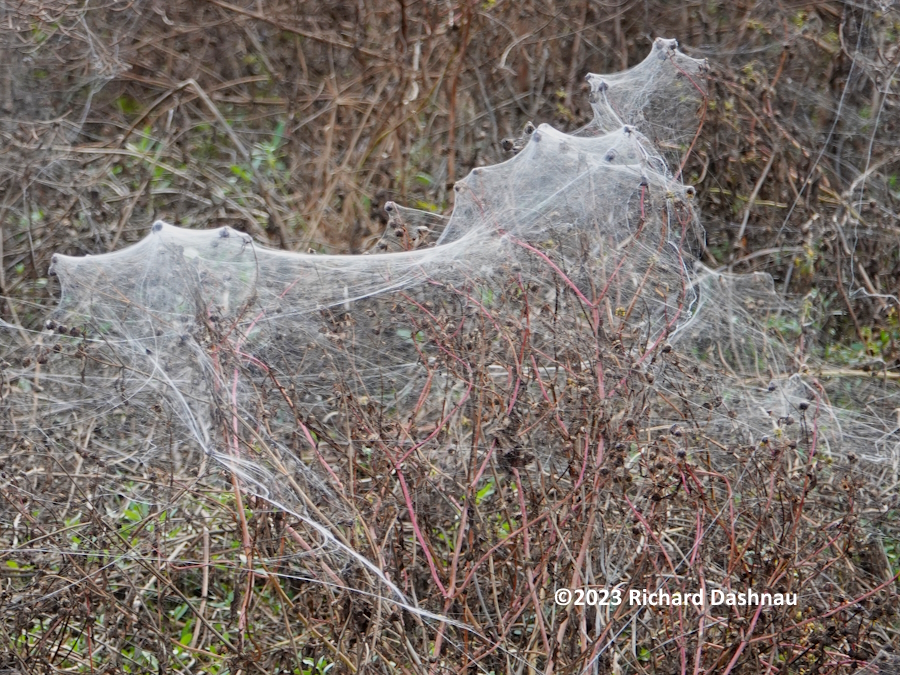
Material
filmed May-June 2006
(update
05/25/2020) Like
almost
everyone these days, I've been staying inside. I have
stopped driving around outside
for...recreational purposes.
BBSP
is just too far away, AND, entrance protocol to the park has
changed
dramatically (even for volunteers). So...I haven't been going
there. So
I'm catching up on old material.
Around
May
of 2006, I found a bold jumping spider (Phiddipus Audax)
*inside*
my car. I caught it, but instead of letting it go outside,
I
decided to release it in my apartment.
I'd been getting a few
insect pests. I didn't see the spider for a while, but then
on 5/14/2006 it appeared near my phone with a prize. A
few days later (5/17/2006, 5/18/2006),
it
appeared to have found a home
behind a framed document I had on the wall (my dog's
pedigree). There were a few times while I was
sitting at
my computer in the evening, when
I had
an odd feeling of being watched. When I looked back over my
shoulder, I
could see her standing on the picture frame and looking my way.
Tiny
dots of light reflected in her eyes.
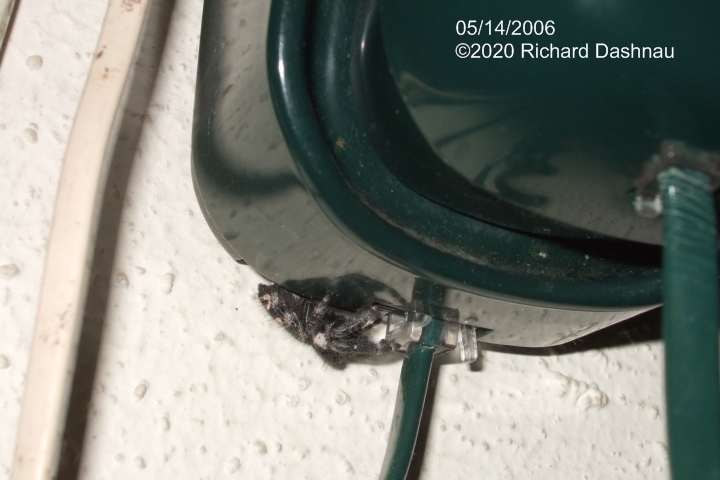
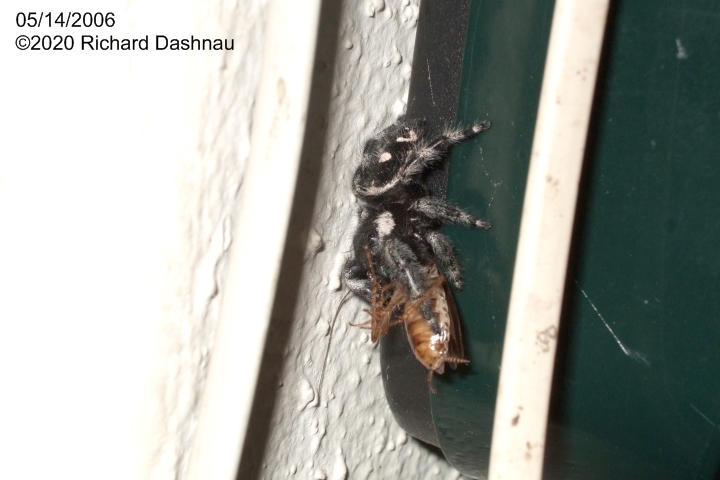
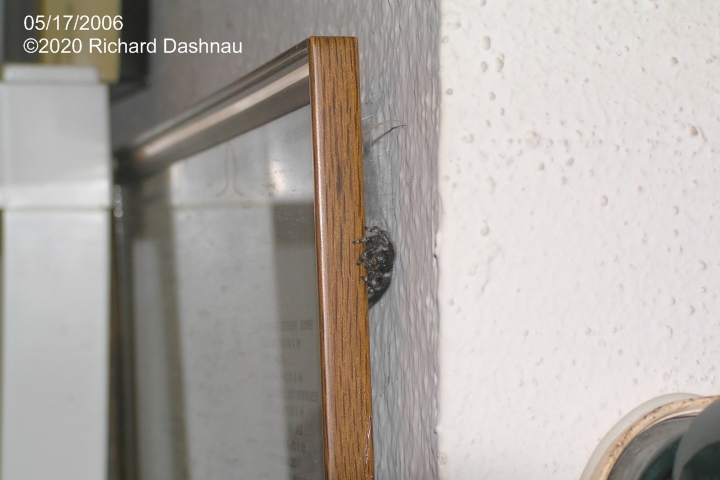
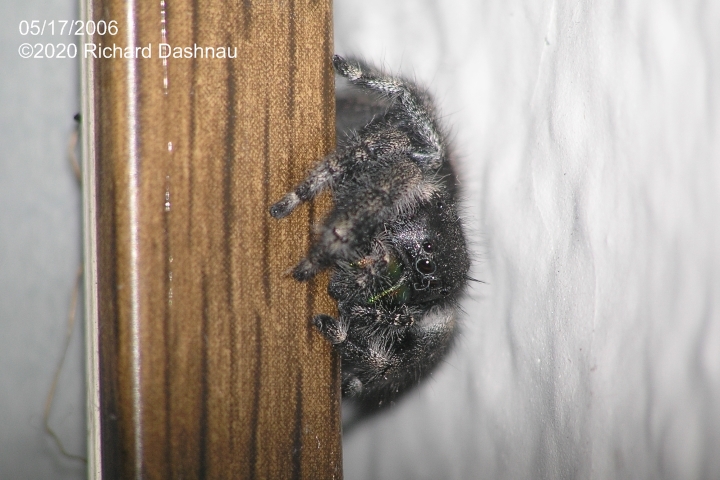
1
5/14/2006
2
5/14/2006
3
5/17/2006
4
5/17/2006
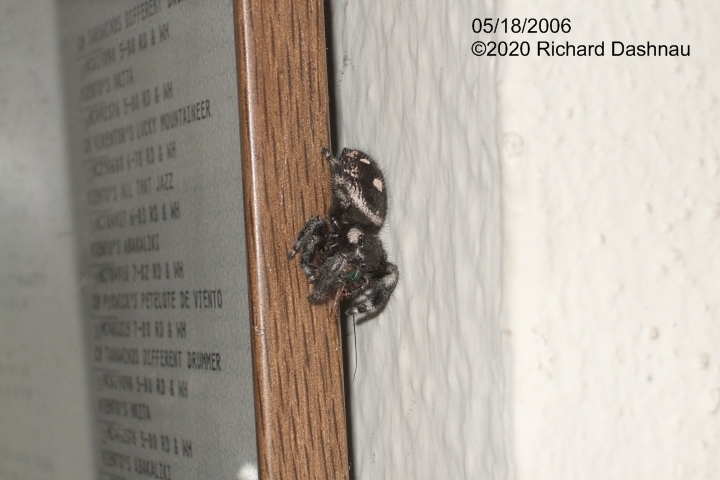
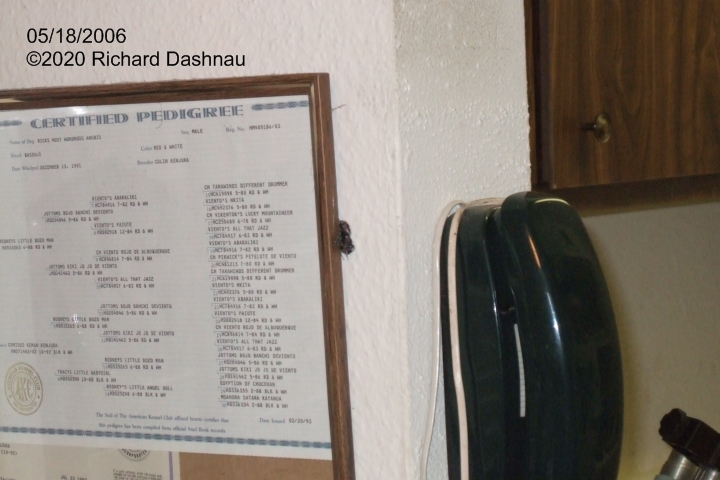
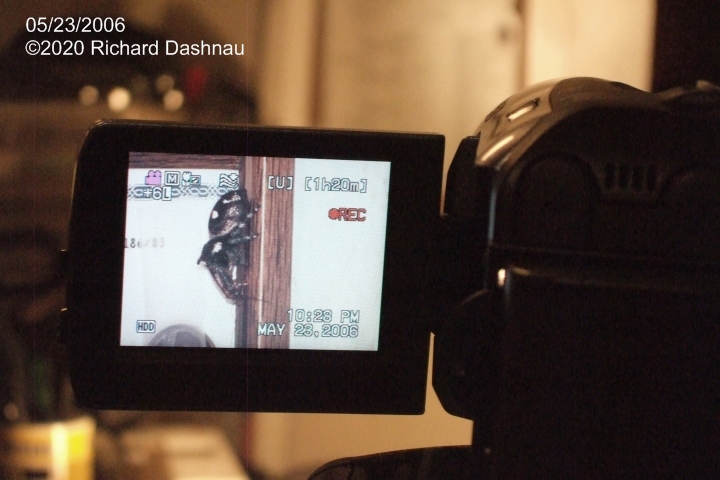
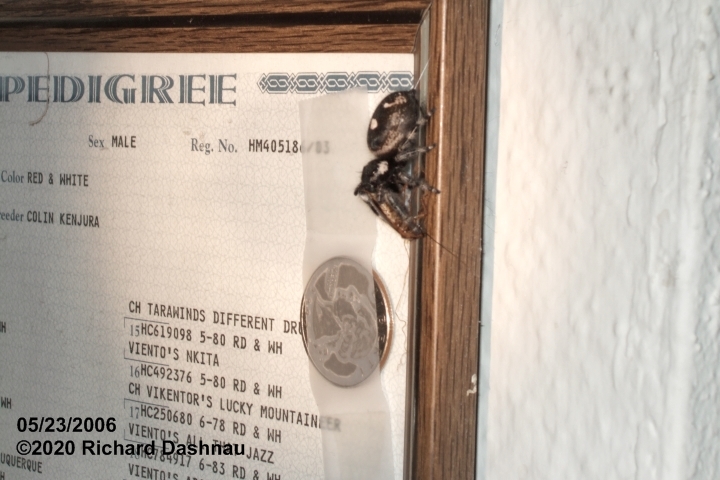
6 5/18/2006
7 5/18/2006
8 5/23/2006
9 5/23/2006
Since
the spider had a home, I decided to try to shoot video of her. I'd
finally gotten a camera that recorded digitally to a hard drive.
Resolution was
720 x 480. Since then (it's been FOURTEEN YEARS today), technology
has
changed. I have tried to enhance the video if I could. Here's video of one of her captures.
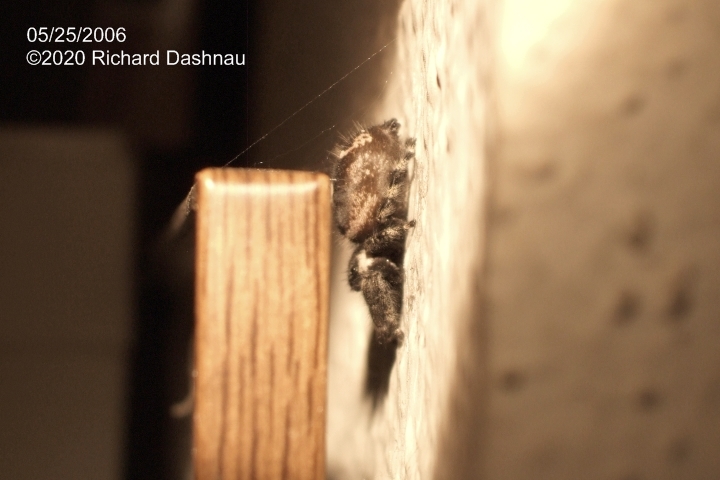
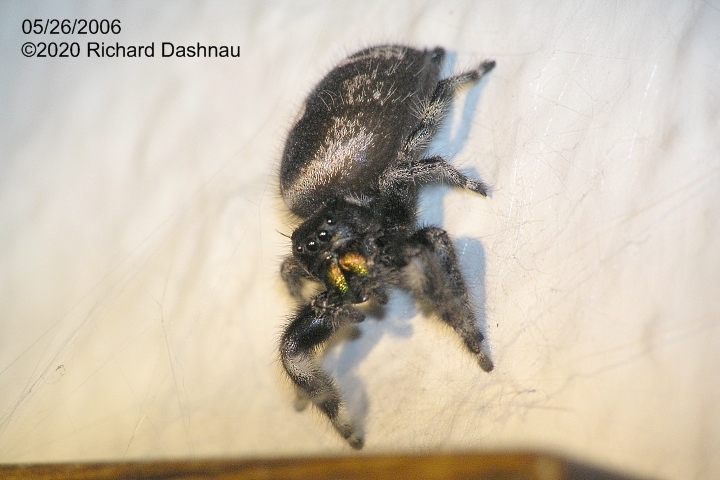
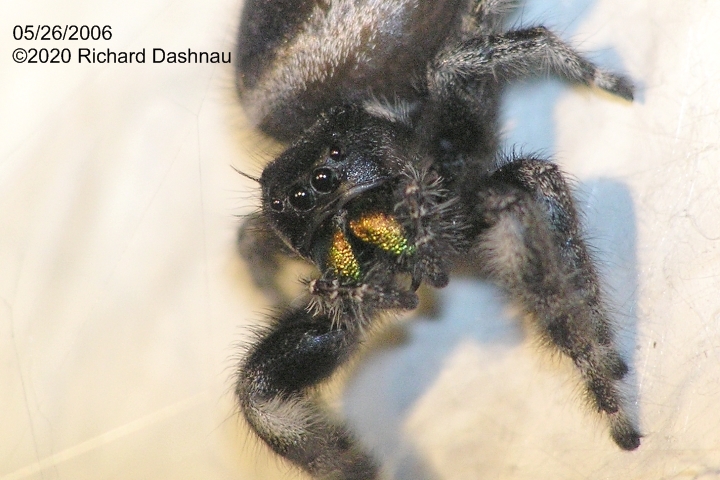
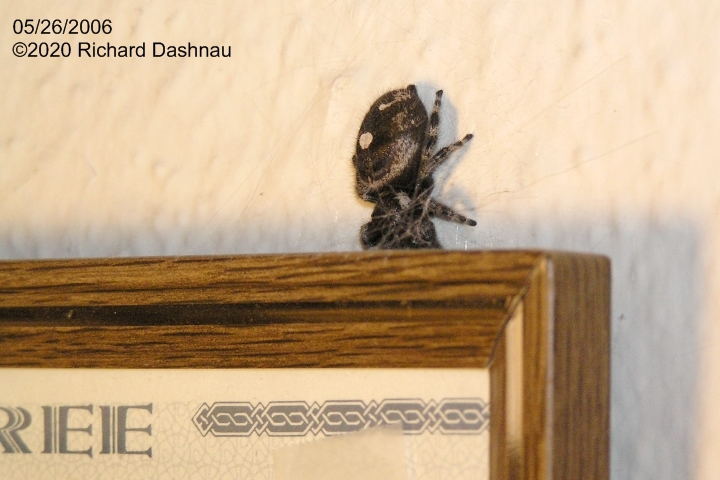
10
5/25/2006
11 5/26/2006
12 5/26/2006
13
5/26/2006
I
didn't notice at the time, but the pictures show how large she
was
getting. The spider was gravid!
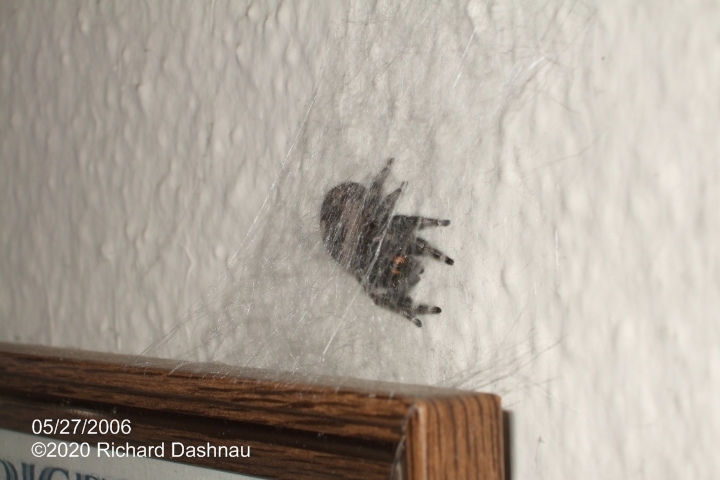
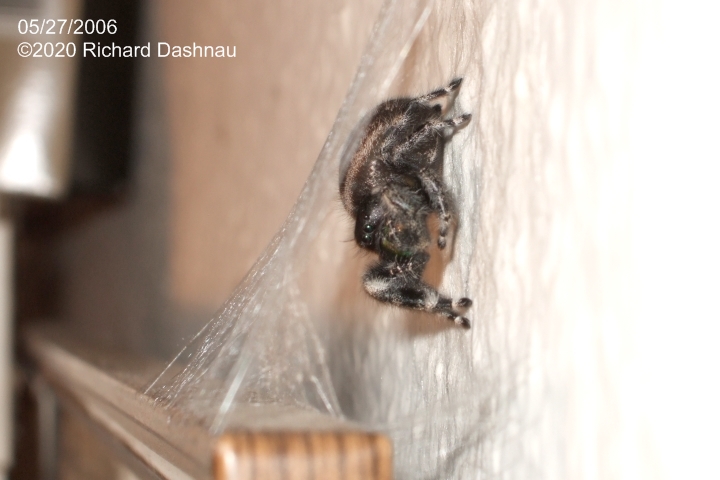
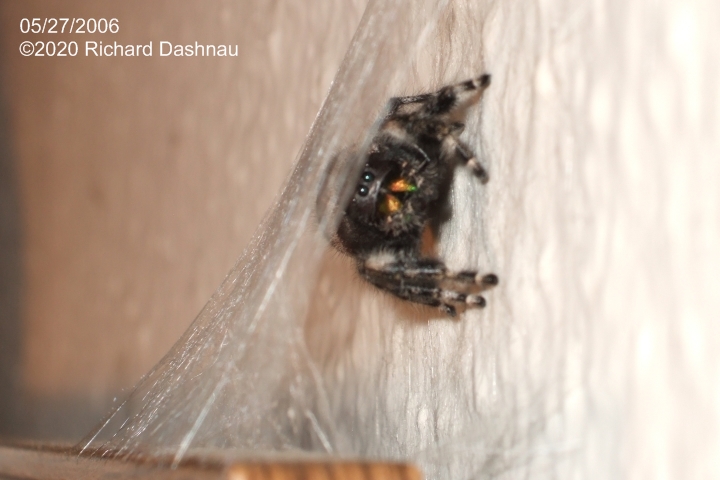
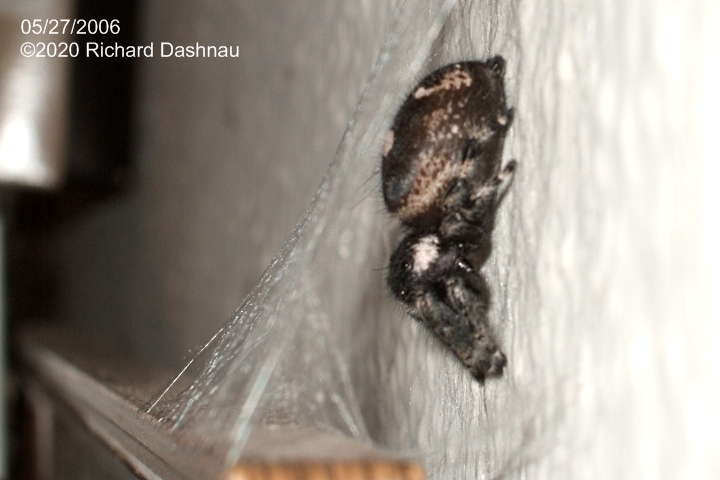
14
5/27/2006
15
5/27/2006
16
5/27/2006
17
5/27/2006
She
began making a nest . Here's
video showing her starting her nest.
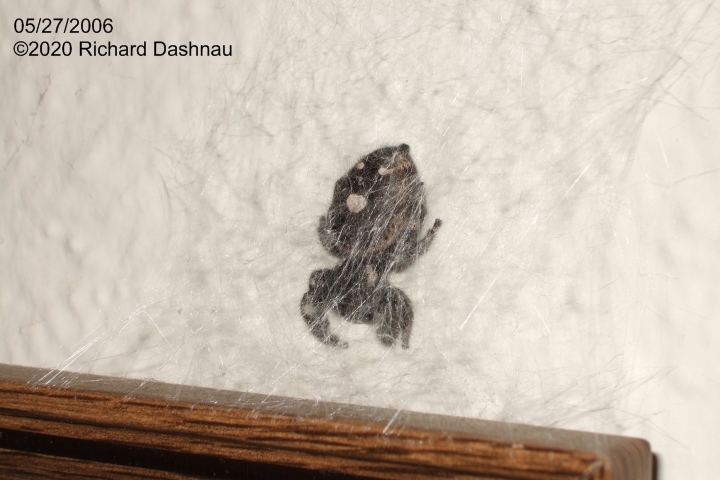
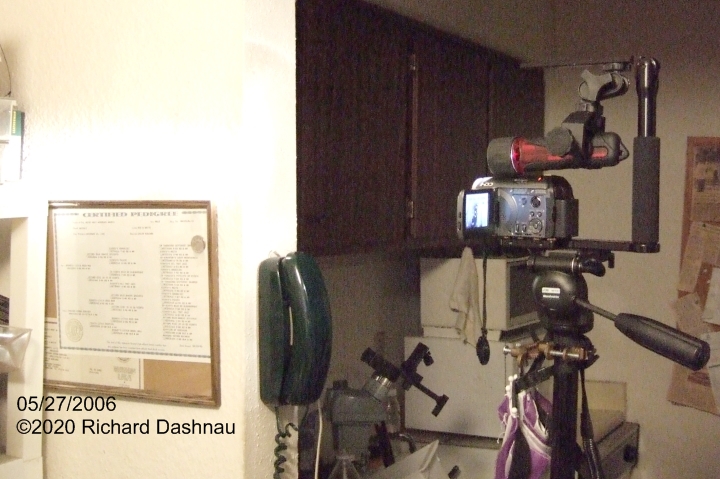
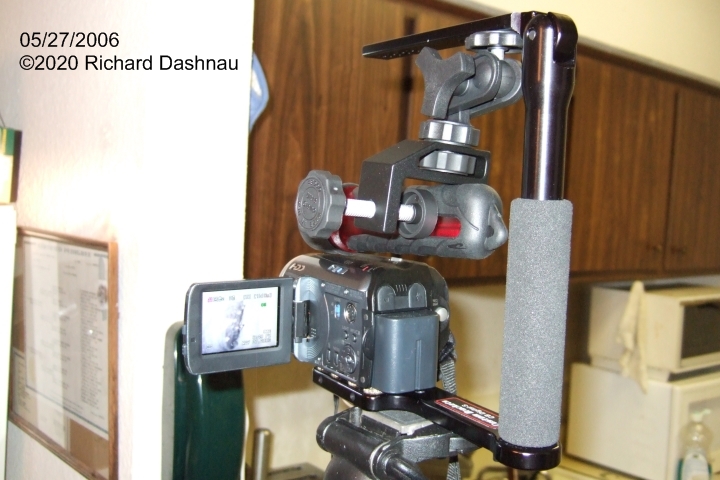
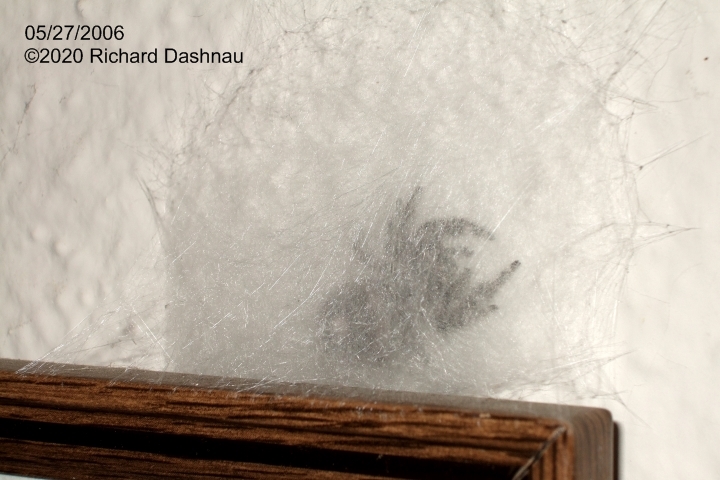
18
5/27/2006
19
5/27/2006
20
5/27/2006
21
5/27/2006
Some
of
these pictures show how I was
shooting video. At the time, I tried using a bright flashlight
for the
light source. It was all I could afford. ha ha ha
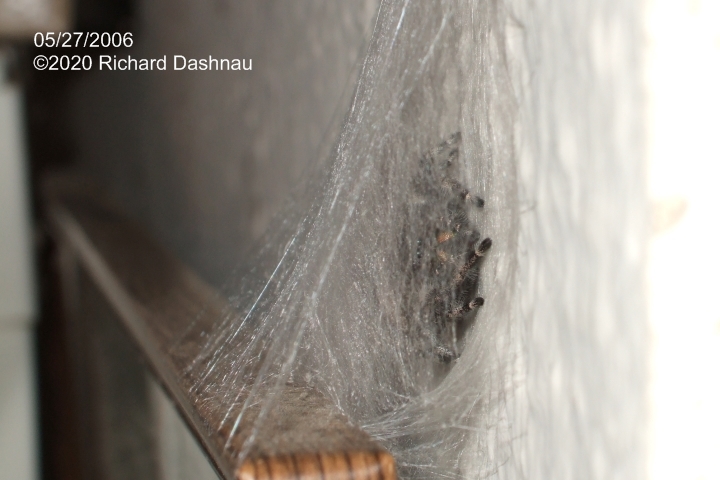
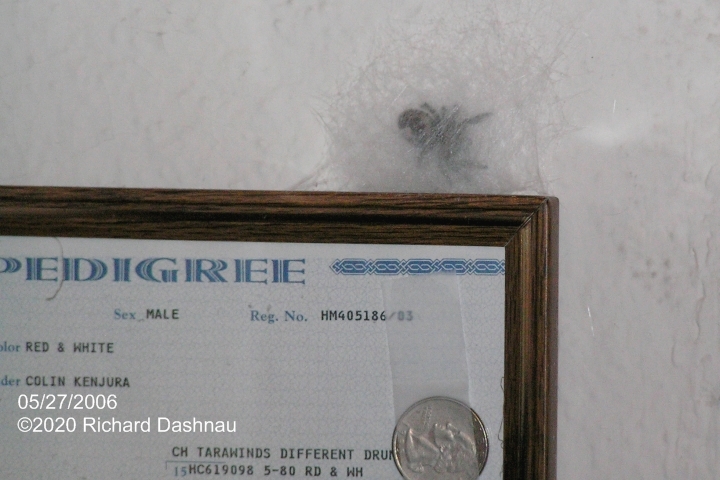
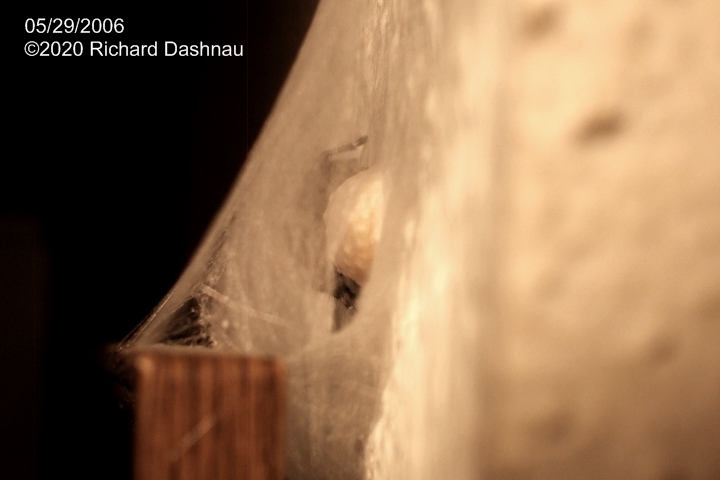
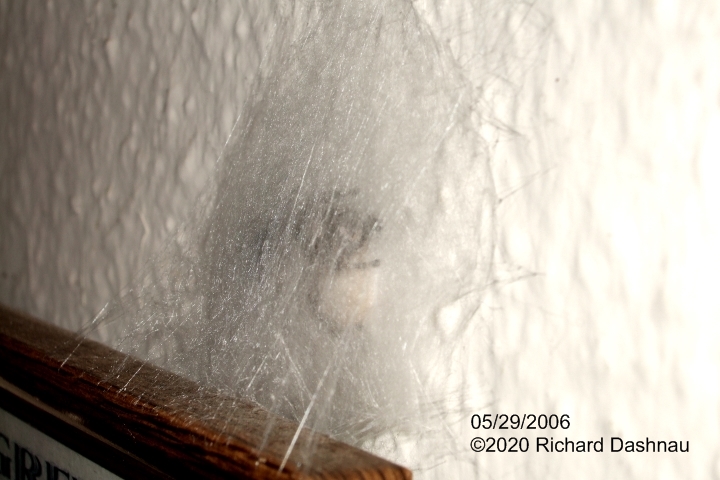
22 5/27/2006
23 5/27/2006
24 5/29/2006
26
5/29/2006
A couple days later, I saw her eggs. I could see
her covering her eggs with layers of webbing. Here's
video showing her covering her eggs.
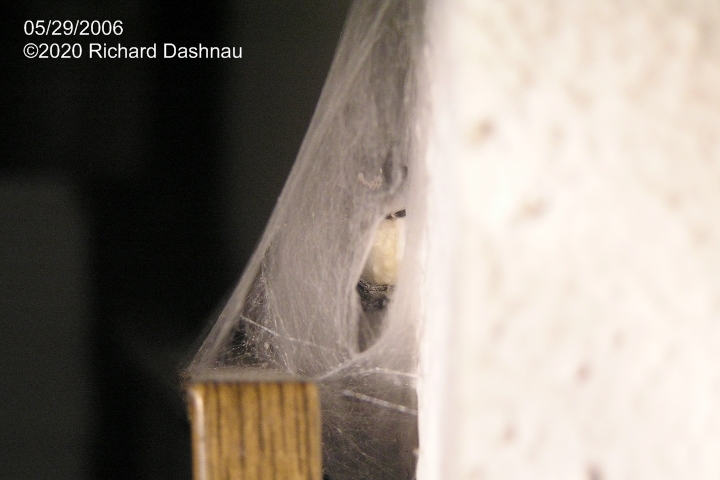
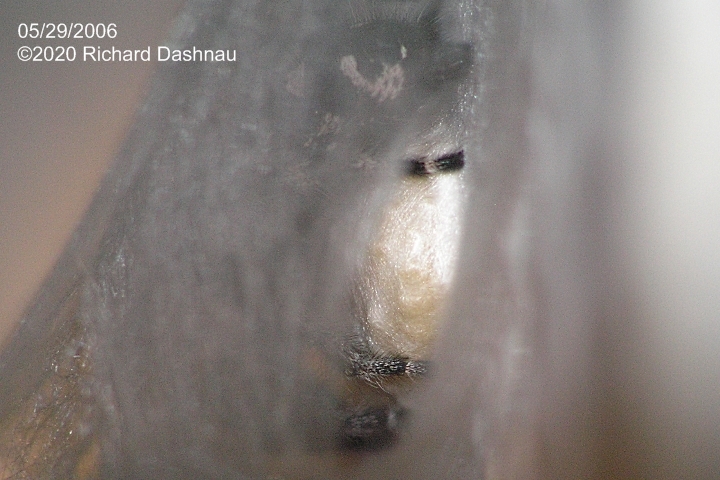
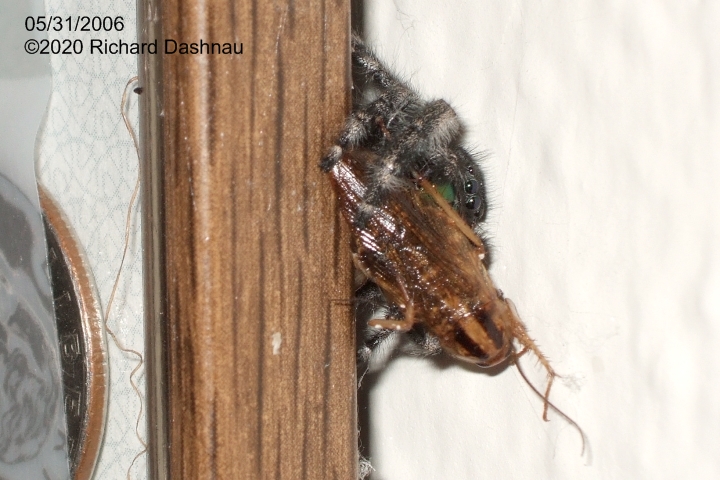
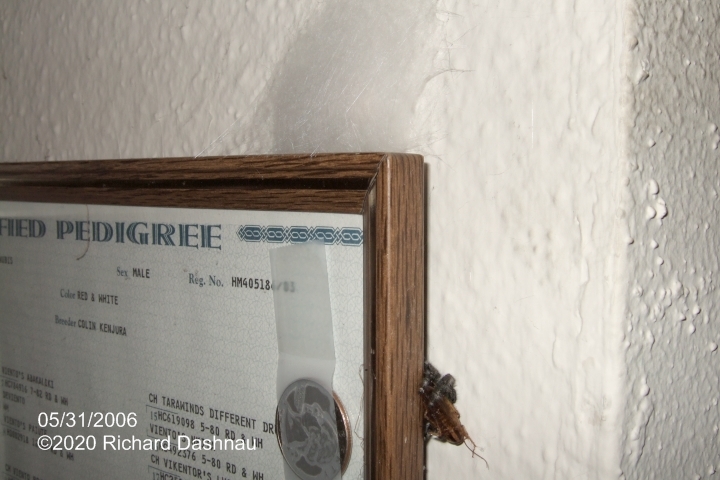
28 5/29/2006
30 5/29/2006
33 5/31/2006
34
5/31/2006
After laying
her eggs, she
continued hunting. Here's
video showing her eating a few times
after laying eggs. She's noticeably smaller in the
video.
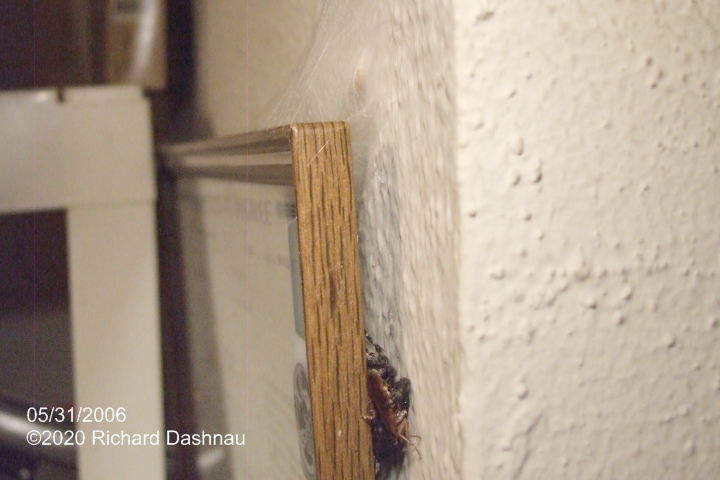
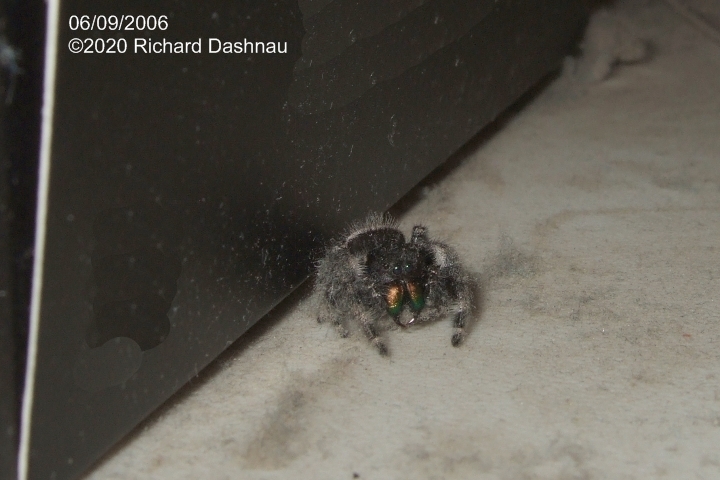
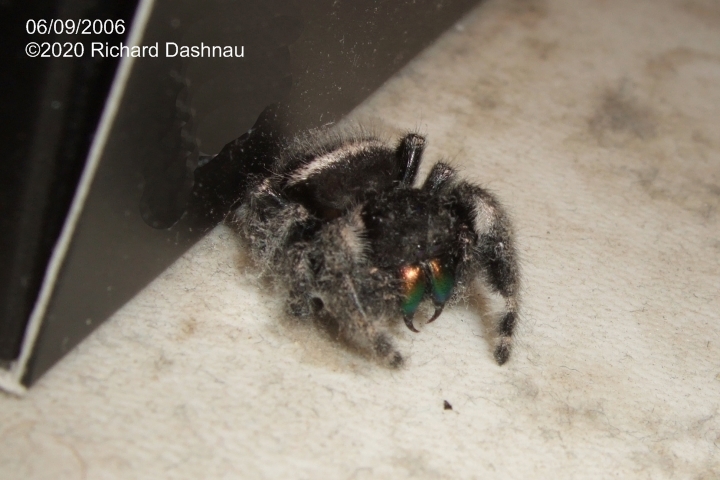
35 5/31/2006
36
6/09/2006
37
6/09/2006
I hadn't seen her for a while, until I found her on a shelf. She
had
died.
6/13 A few more days passed, and then I noticed one little
spider
appear on the nest. It later went back inside. Here's
video
showing the single first instar.
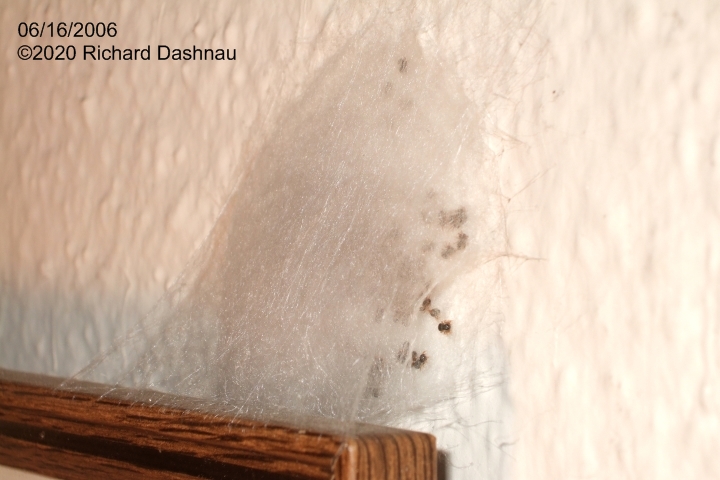
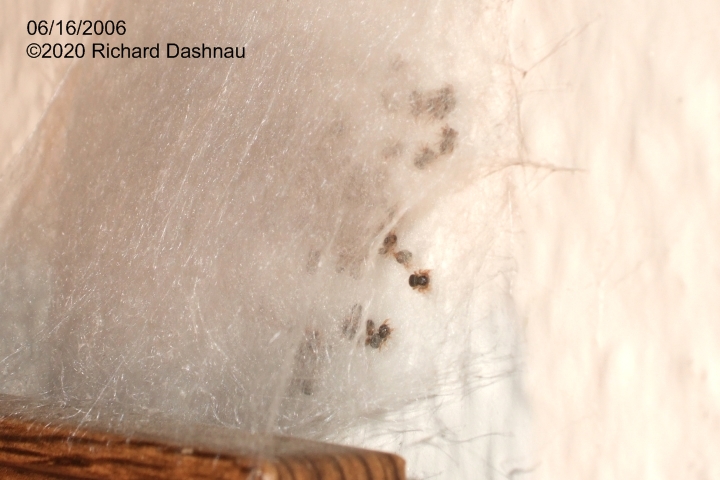
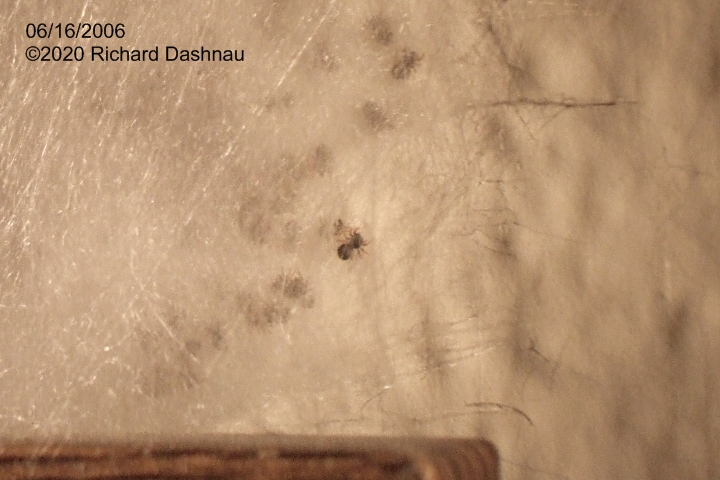
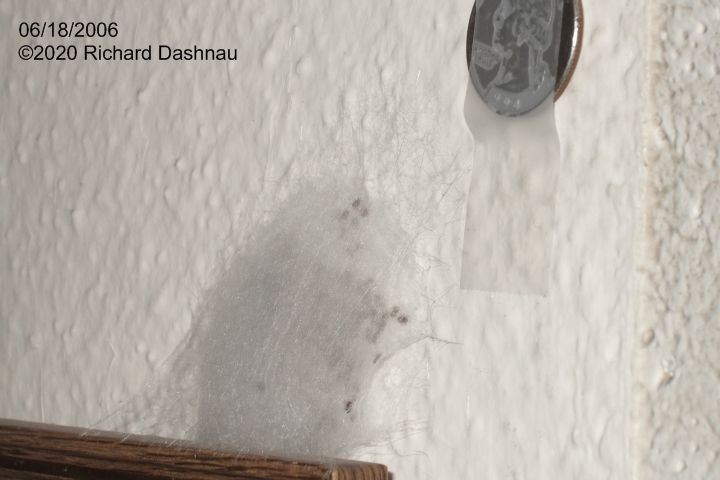
38 6/16/2006
39 6/16/2006
40 6/16/2006
41 6/18/2006
After a few more days, there was more activity in the nest.
6/18 I moved
the quarter onto
the wall. The mass of babies showed as a dark mass under
the
silk.
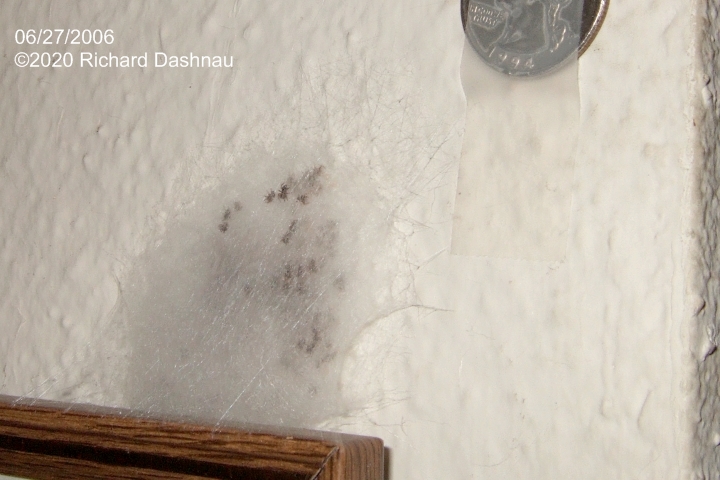
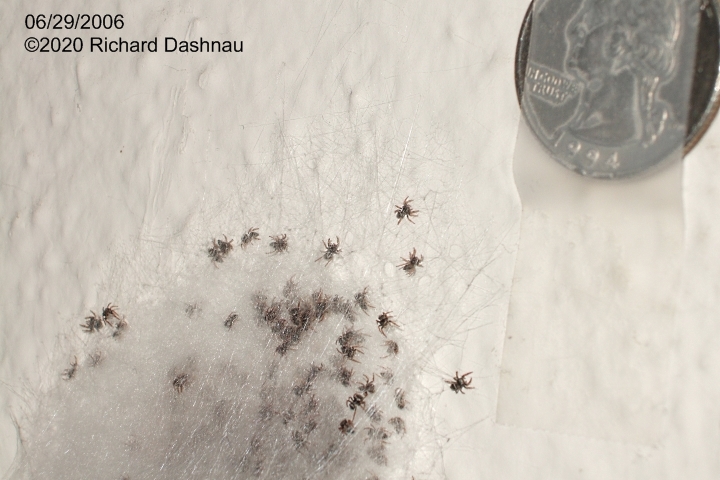
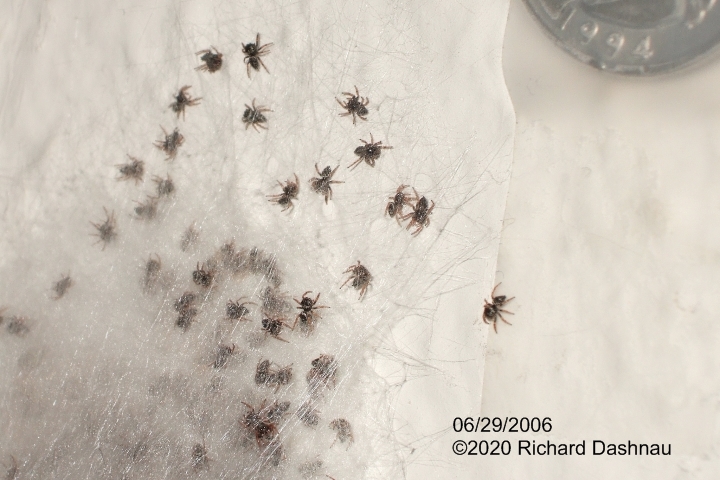
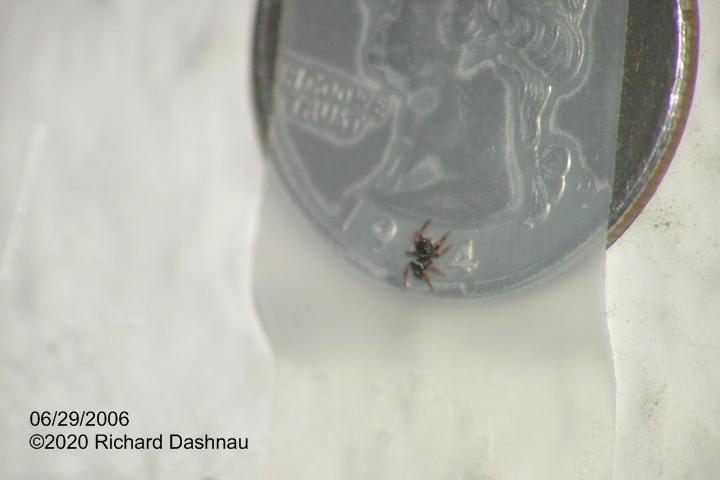
43 6/27/2006
44 6/29/2006
46 6/29/2006
47
6/29/2006
On
6/27 there
was still no
movement out of the silk. On
6/29 the babies
started leaving their shelter.
Here's
video
showing the babies leaving the nest.
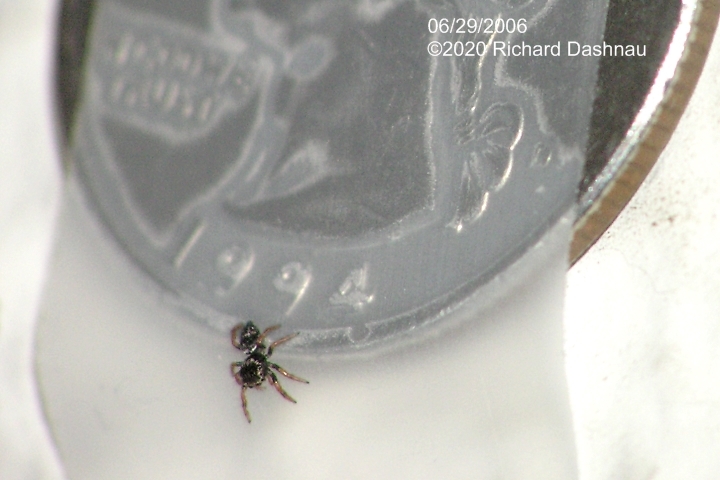
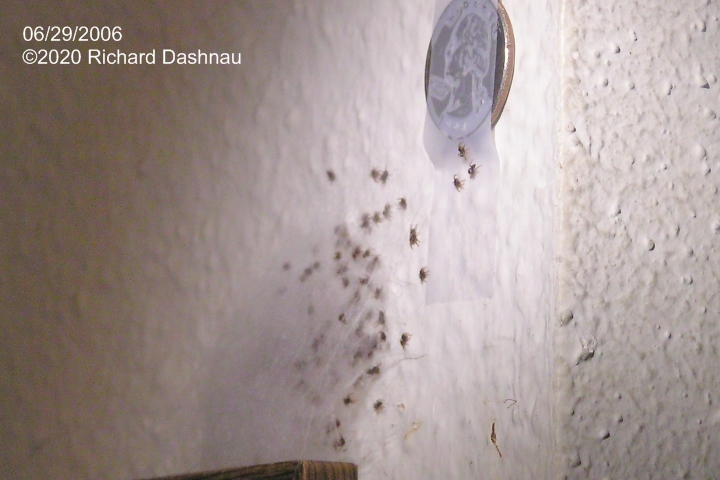
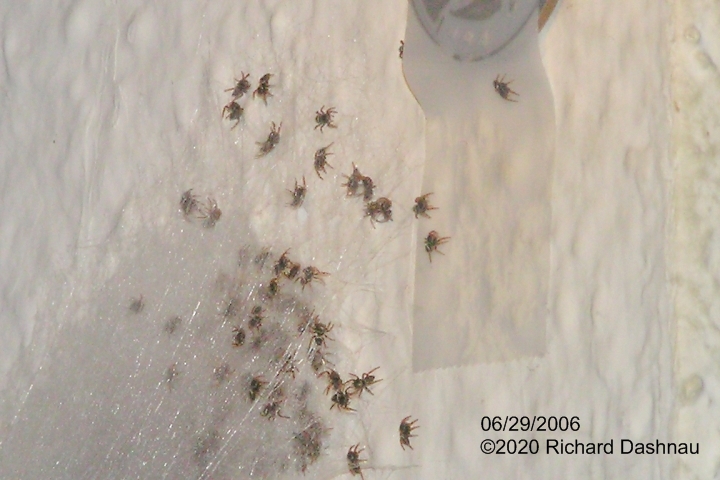
48
6/29/2006
49 6/29/2006
52 6/29/2006
Soon
after, I returned home from work, and found the spiderlings had
scattered
across my ceiling! I captured as many as I could, and
released them
outside.
They were scattered all over the ceiling, and were starting to
drop
down. I didn't have time to grab a camera as I gathered
the
spiderlings. So, no pictures.
6/12/2020--Finally, here is a 10 minute video that summarizes
everything!!
October
03, 2004Finally,
I was standing on one of the foot bridges, and watching a female
alligator
and her young; when I caught a movement in my lower field of
vision.
--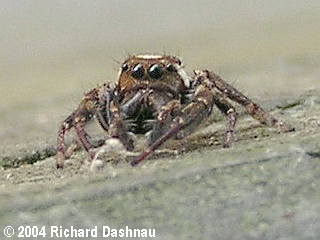 -------
-------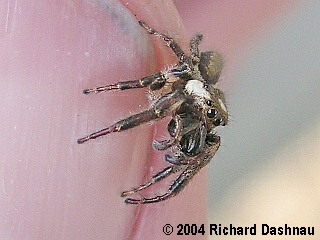 ---------
---------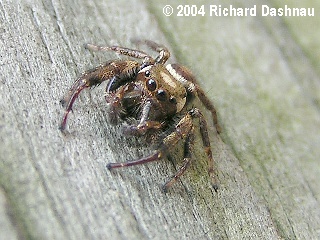
JUMPING
SPIDER
RICK
THUMBING A
RIDE
GET THAT CAMERA OUT OF HERE!
I
looked
down and saw this spider (see JUMPING SPIDER, above) on the rail.
I was
able to get some good shots with the "supermacro" setting on my
camera,
but I had to move the camera close to
the spider to do this.
As
I
was trying to photograph it, the spider decided to jump ONTO my
camera.
Well, that wasn't going to work, so I let it jump
onto my hand,
where I took a few more pictures as
it crawled on my thumb (see RICK THUMBING
A RIDE, above). Note those two large eyes in front, with two
smaller
eyes
alongside. Also, that clinging ability, due to the scopulae, is
evident
as it
clings to my thumb.
It
jumped
off, catching itself by the typical "safety line" (a friend of
mine
likes
to call it a "butt tether"), and it returned to the rail (see GET
THAT
CAMERA OUT, above). I wanted to
try to get more pictures of the safety
line in action, but a park visitor came by to ask me about a large
alligator.
So, I left.
September
09, 2004The
image below (ANY KEY?) shows that one is usually not very far from
some
species of spider. I was at work, in my office, busily composing
flowcharts,
when I saw a furtive
movement out of the corner of my eye. When I looked,
I noticed a small spider moving around my assorted papers and
hardware,
hunting. I turned to get my camera (I usually have mine near
me),
and
when I turned back, the spider had gone. I'd seen it, or one
like it,
elsewhere in my office, and just sent good thoughts towards it.
-----------------------------------------------------------------------------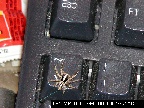
ANY
KEY?
At
around
10:00, I reached for my mug of coffee...which was actually pretty
cold
by then (fortunately). When I looked down into the mug, I saw a
spider
half-submerged in the coffee. OH, NO! Grabbing a
fork, I gently fished
the spider out, and set it on my desk. After a few seconds, it
started
crawling around. This time, I was able to get my camera, and
that's how
these pictures came to be.
This
is a member of the Jumping Spider family (Salticidae), and might
be a Plexippus paykulli, judging by the white
stripes. (I've got
a few more pictures--and video clips--of jumping spiders on my
jumping
spider page.) Take a closer look at the RICKUBISCAM and you
might notice
a blue "thread" coming of the end of its abdomen
(opisthosoma). This
is a web coming from its spinnarets. Jumping
Spiders usually attach a "safety
tether" as they move about, in preperation for jumping. If they
miss a
target, or jump off an edge, they can use the tether to stop their
fall
and climb back onto a surface.
The two pictures below show this tether
closer (KEYBOARD CLOSER; REAL CLOSE,below).
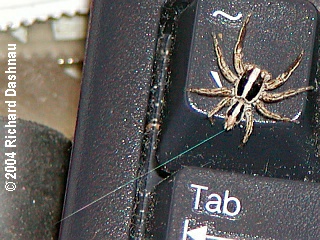 -
-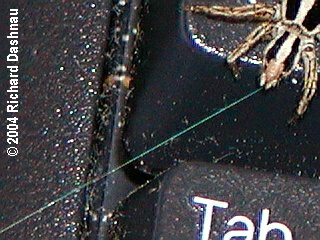 -
-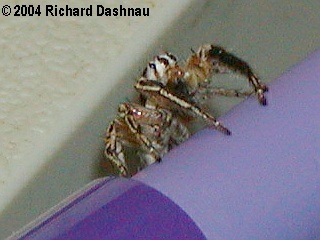 -
-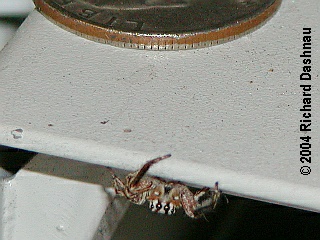 -
-
THE KEYBOARD CLOSER
THE KEYBOARD REAL
CLOSE
ON THE
PEN
ON
THE
EDGE
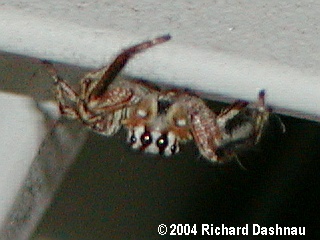
ON THE EDGE CLOSER
I'm
not sure what to make of the reddish patch on the tip of the
abdomen.
The
spider moved to the pen (see ON THE PEN, above), and jumped off to
the
side, and then onto my keyboard housing.
(see ON THE EDGE, and ON
THE EDGE CLOSER, above). Note those two large frontal eyes, also,
that's
a quarter in the picture over the spider.
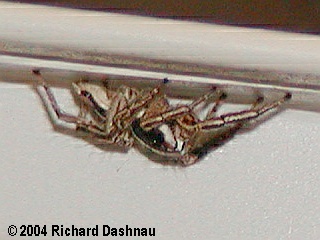 -
-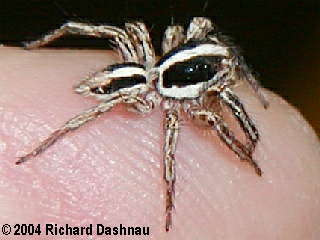 -
- -
-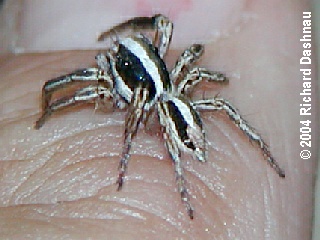 -
-
UNDERNEATH
ON RICK'S
FINGERTIP
LATERAL
EYES
ON
RICK'S
CUTICLE
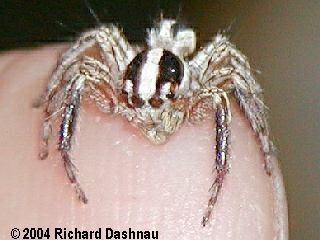
FACE-ON RICK'S
FINGER
The
spider
got a little nervous when I was taking pictures, and walked under
the
top
of the case (see UNDERNEATH, above). This illustrates something
else
that
spiders can do; which is
cling to smooth surfaces. The end of certain spider's
legs (the tarsus) has, besides claws, very tiny hairs called
"scopulae".
Each of these hairs is split, in turn, into hundreds of finer
hairs.
For
example, in Biology of Spiders by Rainer F.Foelix, it says
that a crab
spider with 30 "scopular hairs" on each foot can have each
of those
hairs split into 500 to 1000 end feet. That
makes a total of about 30 x
750 = 22,500 for ONE foot! 8 feet with this number of microhairs
would
be 8 x 22,500 = 180,000 contact points! Research shows that each
of
these
very
small
hairs will adhere to a surface through molecular attraction (they
are small enough for this kind of effect to take place); and the
combined
action of these thousands of hairs can support the
weight of the spider.
Different species of spiders have different numbers of
scopulae. Those
spiders that actively hunt (such as Jumping Spiders) have greater
numbers
of these, allowing
them to pursue prey (or escape from being prey)
over almost any surface, in any direction. For a recent
article on these
scopulae, look at The
Institute
of Physics page. It's got great (but
huge--over 1mb) pictures
of the hairs.
Finally,
I enticed the spider to crawl onto my finger for some better
closeups,
but with limited success because it kept moving (see above, ON
RICK'S
FINGERTIP).
Looking closer, you may notice how the flash has caused
highlight to glint
on two (or four) spots on the lateral edge of the spiders
carapace.
These
are four eyes (two pairs),
which--with the 4 frontal eyes (see FACE-ON
RICK'S FINGER)--make up the 8 eyes on this species. the last image
below
is from a short clip of the spider moving up my finger.
Finally,
the spider went on about its business, and I went back to
work. Coffee
break was over.
---------------------------------------------------------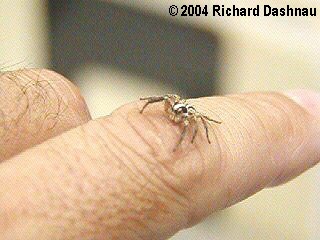
SHORT
CLIP ON MY FINGER 409KB
November
29, 2003 It
was
a beautiful day. I sat down on the grass to be near Anubis. I
could
see, in among the short blades, the movements of small spiders. As
I
looked
around, I
spotted a small spider catching some sun on a leaf. So, I took
some pictures, and finally slid a quarter next to the spider and
took a
few more. As you can see in the picture below
(NO SMALL CHANGE), it posed
nicely with the quarter.
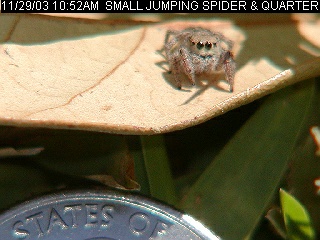 -
-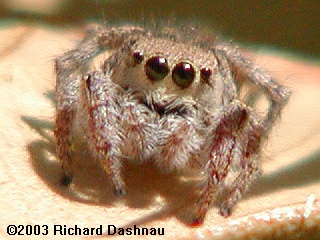 -
-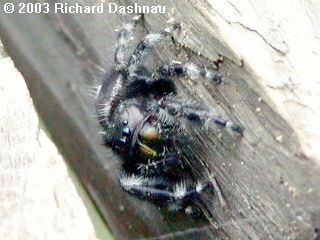 -
-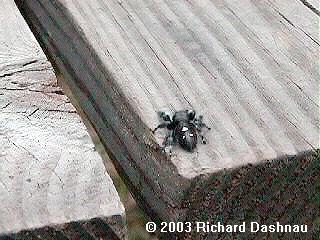 -
-
NO SMALL CHANGE
LOOK AT THOSE EYES!
DARING JUMPER
DARING JUMPER EXPLORES
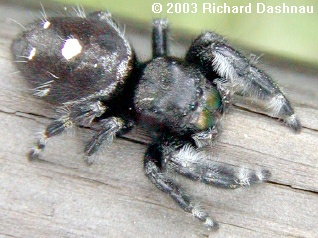
AUDAX
FROM ABOVE
The
picture above (LOOK AT THOSE EYES) is cropped from one of the
other
pictures.
The four eyes in front, with the two really big center pair (as
well as
two more sets on the
sides of the cephalothorax) help identify this as
one of the many species of "jumping spiders". Although I can't
guess
which
spider the brown one is, I can be pretty sure about
the
Daring Jumping
Spider; Phidippus audax (see DARING JUMPER, above.). I took
the pictures
the Daring Jumping Spider in September of 2002. Note the
large eyes
also in front
on this spider. Also, those iridescent "fangs", or chelicerae,
are another identification key for this spider. The next
image (DARING
JUMPER EXPLORES, above) is a frame from
a short video
clip (flv video 462kb) of the same spider. Watch as
it investigates
the edges of the park bench. This clip shows the spider at a more
common
viewing distance than
the macro shots above.
I
could
watch jumping spiders for hours; they look so aware--and when they
pounce
on something...WOW! The next picture (AUDAX FROM ABOVE, above)
shows the
same spider from the top.
Jumping
spiders are classified in the family Salticidae. Many of these are
hard
to tell apart, and I sure can't tell exactly which species this
one is.
Spiders as a whole are in the order Aranae. This is split into two
suborders;
Mygalamorphae and Araneomorphae (the Foelix book lists a another
order
before these two, Mesothelae.).
The first group is generally made up of
"primitive" spiders, and in Texas, tarantulas are the most common
of
this
type. Most of our spiders belong to the second group,
though,
and this
group is further divided into families. These divisions are made
by web type, or hunting behavior (for instance the Salticidae,
which
are
the jumpers), or certain other characteristics.
Jumping
spiders don't make webs to snare prey, although they do set down a
"safety
line" before they leap (here's a clip
365kb , also look at the Spiders
1
page). According to
A Field Guide to Spiders and Scorpions
in Texas by John A. Jackman; they can leap many times their
own body
length, and the safety line can be used to recover in case they
miss
their
target. Also, while they are moving around many of these jumpers
constantly
tap where they're walking with their pedipalps, possibly sensing
chemical
traces of prey. Another interesting
observation, from Biology
of Spiders by Rainer F. Foelix; is that--depending on the
species--jumping
spiders jump by pushing off with either their last (4th) pair of
legs,
the 3rd pair, or a
combination of the 3rd and 4th pair. This makes sense,
considering that they usually use the front pair (1st) of legs to
help
snare their prey. Also Jumping Spiders are generally
credited
with
having the best eyesight of all the spiders. Since they can see
further
than most spiders (some orbweavers are almost blind), the react to
movement,
and move towards it, to
investigate it. This could be why some of
them (like the Daring Jumper) cause some people to become
unnerved. The
spiders seem unafraid, and, in fact, seem to be sizing us up
rather
than
running away at our approach. This kind of behavior from a
creature
about
the size of a quarter ( see the image below, DARING JUMPER AND
QUARTER)
is usually unexpected.
(The image below is actually among the first I took
of this spider. I had it on a table inside trying to photograph it
before
I released it outside on one of the park benches and took
more
pictures.)The
spider in the video clip leaping onto the "lovebugs" is the same
type
as
in this image(see WHAT ARE YOU LOOKING AT, below). This spider was
about
a half-inch long,
standing on a wall, and as I leaned forward with the
camera, about 12 inches away, the spider looked up at me, as if
daring
me to try something. A closeup of the face (WHAT BIG EYES,
below) shows
again the eye arrangement which these spiders possess.
Another version
of this picture has appeared earlier above, since I photographed
it in
Sept. of 2002. I've guessed
that this one is a Plexippus paykulli, but
it's only a guess.
------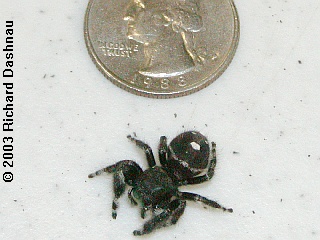 ---------
---------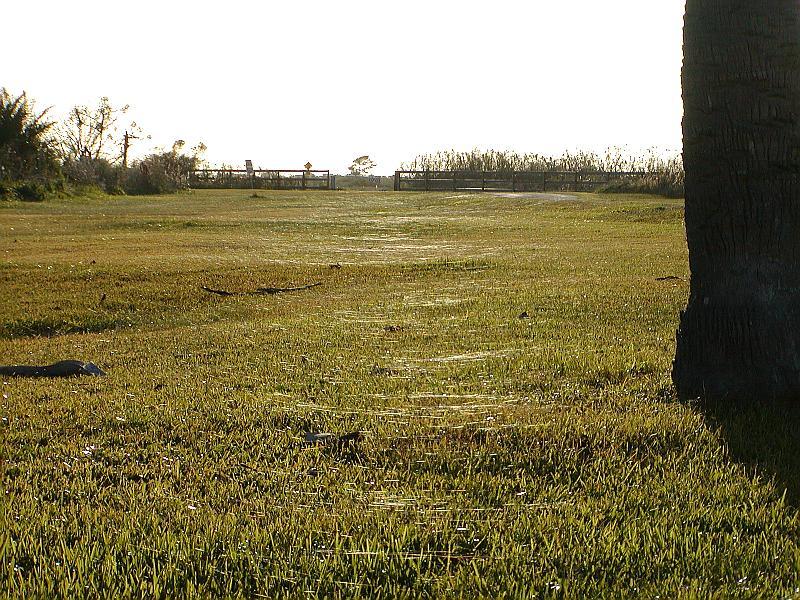 ----------
----------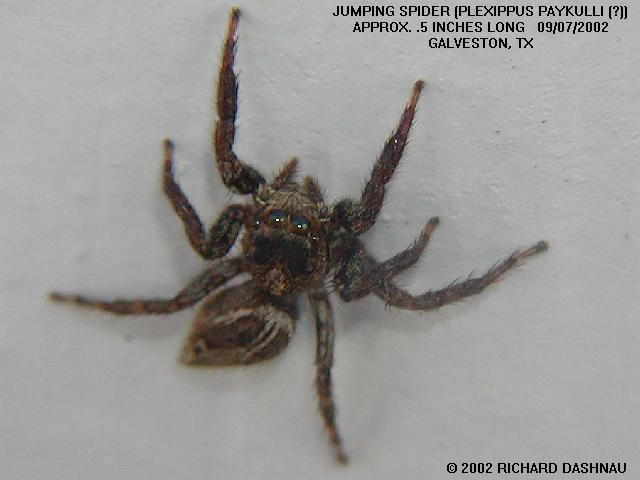 -------
-------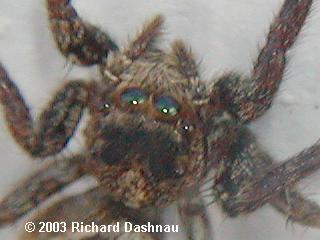
DARING JUMPER AND QUARTER
MY GOSH, IT'S FULL OF
STRANDS!
WHAT
ARE *YOU* LOOKING
AT?
WHAT BIG EYES YOU HAVE
As
I
was looking through the grass, I could see a number of webs
glinting in
the sunlight. Seeing those made me think of another time (last
January),
when I saw the yard covered by strands of
silk (see MY GOSH, above, or
the bottom of my Critters
webpage). Could all of that have been caused by spiders in the
grass?
If
so....what a mass of spiders, and what a huge number of small
creatures
must have been eaten!
September
08, 2002Inhabitants
of
Texas are familiar with "love bugs", those black insects that--to
quote
an old airlines ad--"fly united". The scientific name for them is
plecia
nearctica Hardy,
and they are mainly annoying. The bodies of these
insects are acidic. Clouds of these were flying around my friend's
house.
I decided to take my camera and look around the house for some
spiders,
which I'd seen before. I wasn't disappointed. There were quite a
few of
them foraging. I spent some time watching their antics. I
noticed
two jumping spiders about 4 feet apart that were
attacking the love bugs
(yay!).
-
-- -
- 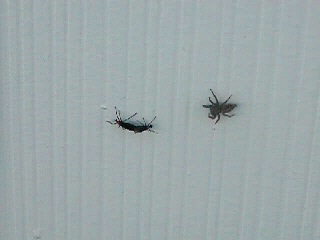
JUMPING
SPIDER
HEY!
GET A ROOM!
The
one on the left seemed to be catching and eating them, while the
one on
the right was catching them and "spitting them out". I got a
pretty
good
macro shot of one of them (see JUMPING SPIDER,
above). Note the huge
center pair of eyes. See how he seems to be looking up at me, and
daring
me to try something? They're pretty feisty. I was able to
get
a short
clip of one spider making a
successful attack and then dropping its prey
(the "spitting it out" spider) . HEY, GET A ROOM (above) is from
this
clip.
To see the clip, click here.
(flv
video 365 kb).
If
you'd like to know more about the park follow these links:
Brazos
Bend
State Park
The main page.
Brazos
Bend
State Park Volunteer's Page The
volunteer's
main page.
Click on
this image 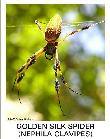 to see a flv video movie (942kb) of a series of 9 11 x 14
posters
I'm working on.
to see a flv video movie (942kb) of a series of 9 11 x 14
posters
I'm working on.
Go
back to my home page, Welcome
to rickubis.com
Go
back to the RICKUBISCAM
page.
Go
back to the See
the World
page.






















































































